Welcome to Entre Ríos Province, a province in eastern Argentina known for its abundant wildlife and a vast array of bird species. The province is home to more than 400 species of birds, including waterfowl, raptors, and songbirds.
From the colorful swallowtail hummingbird to the majestic Andean condor, Entre Ríos offers a wide variety of birds for birdwatching and birding enthusiasts.
Whether you’re looking to view common songbirds in your backyard or take a trip to the province’s wetlands to observe rare and endangered species, Entre Ríos has something for everyone. So come and explore the beauty of Entre Ríos’ avian wildlife.
1. Southern Screamer
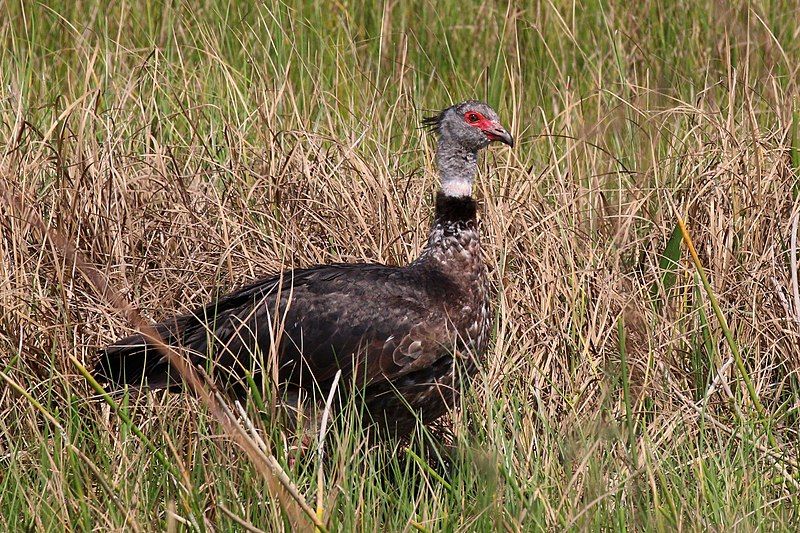
The southern screamer is an avian species that belongs to the family Anhimidae, which is part of the order Anseriformes. This species of bird is found in the South American countries of Argentina, Bolivia, Brazil, Paraguay, Peru, and Uruguay.
It is a rather unique bird, as it is one of the few species that are part of the Anhimidae family. The southern screamer has a rather distinctive appearance, with a large, black and white bill, brown eyes, and a thick, rounded head.
Its body is mostly grey in color, and its wings are black and white. The southern screamer’s legs are short and stout, and its feet are equipped with webbing that makes it well-suited for swimming. This species of bird is a vocal one, and its call is anything but subtle.
It is known for its loud, shrill scream, which can be heard from up to a mile away.
The southern screamer is also capable of producing a variety of other vocalizations, ranging from low grunts to high-pitched whistles. The southern screamer is a gregarious bird, often found in flocks of up to several hundred individuals.
It forages for food on the ground, eating a variety of insects, as well as small fish, frogs, and other aquatic creatures.
It is also known to feed on grain and other plant material. Overall, the southern screamer is a fascinating species of bird, and its presence in the countries of South America is an important part of the local avian diversity.
| Kingdom | Animalia |
| Phylum | Chordata |
| Class | Aves |
| Order | Anseriformes |
| Family | Anhimidae |
| Genus | Chauna |
| Species | C. torquata |
2. White-fronted Woodpecker
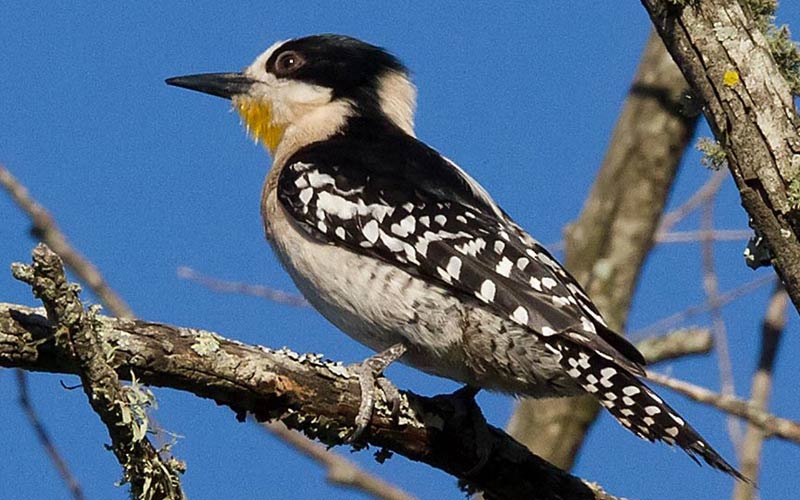
Source: ebird.org
The white-fronted woodpecker is an avian species that belongs to the family Picidae. It is mainly found in three countries, namely Bolivia, Paraguay, and Argentina.
These countries are home to several different habitats that provide a suitable environment for the woodpecker to reside in. These habitats include subtropical or tropical dry forests, subtropical or tropical dry shrubland, and subtropical or tropical high-altitude shrubland.
For example, subtropical dry forests are characterized by sparse vegetation, such as low-lying shrubs and trees, and they are usually found in areas with a dry climate.
The subtropical or tropical dry shrubland is a habitat that features a variety of shrubs, grasses, and other low-lying vegetation, such as cacti.
Finally, the subtropical or tropical high-altitude shrubland is a habitat consisting of shrubs and other vegetation that grow at higher altitudes. All these habitats provide an ideal environment for the white-fronted woodpecker to thrive.
| Kingdom | Animalia |
| Phylum | Chordata |
| Class | Aves |
| Order | Piciformes |
| Family | Picidae |
| Genus | Melanerpes |
| Species | M. cactorum |
3. Snail kite
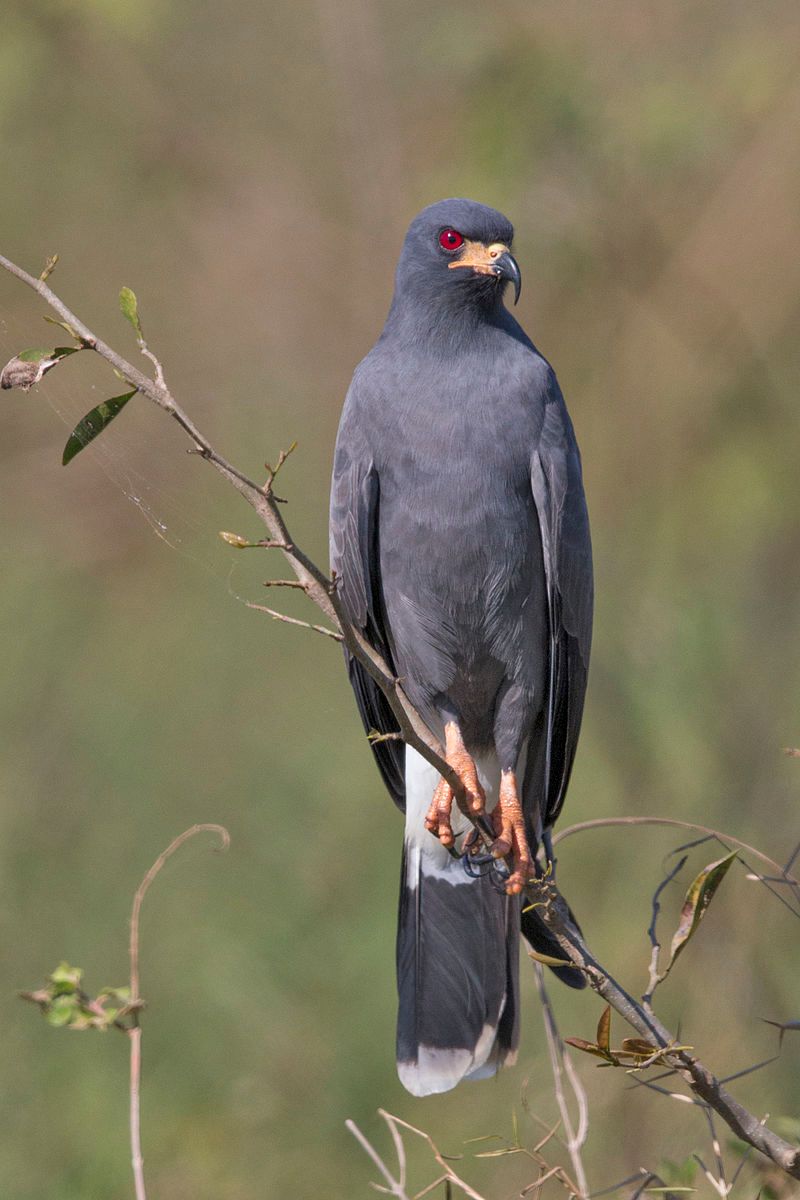
The snail kite is a species of bird of prey that belongs to the family Accipitridae, which also includes eagles, hawks, and Old World vultures.
This species is closely related to the slender-billed kite, which has recently been reclassified to the genus Helicolestes, leaving the genus Rostrhamus with only one species – the snail kite. In other words, the snail kite is now the only species in its genus.
As a result of this reclassification, the snail kite is the only species in the genus Rostrhamus. The snail kite is a medium-sized raptor found in tropical and subtropical parts of the Americas. It is distinctive in appearance with its long curved beak and reddish-brown body.
The snail kite feeds predominantly on apple snails, which it locates by sight while soaring above its wetland habitat. It is a threatened species due to habitat loss and other human disturbances.
Conservation efforts have been put in place to help protect the snail kite and its wetland habitat.
| Kingdom | Animalia |
| Phylum | Chordata |
| Class | Aves |
| Order | Accipitriformes |
| Family | Accipitridae |
| Genus | Rostrhamus |
| Species | R. sociabilis |
4. Chalk-browed Mockingbird
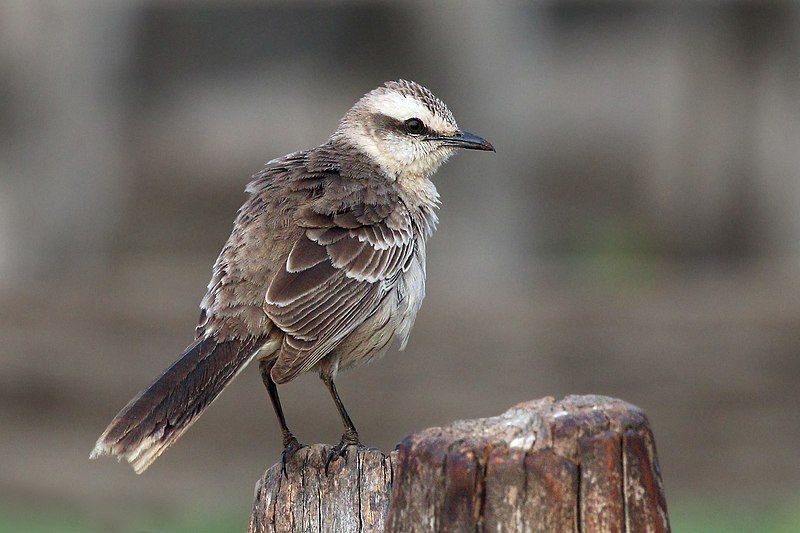
The chalk-browed mockingbird is a species of bird belonging to the family Mimidae. Native to South America, it is found in multiple countries, including Brazil, Bolivia, Argentina, Paraguay, Suriname, and Uruguay.
It is a small bird, with a length of around 22 cm and a wingspan of 32 to 34 cm. Its back and wings are dark grey, while its underside is light grey. It is known for its distinctive white eyebrow, which gives it its name.
It has a slight crest on its head, and its tail is long and rounded. The chalk-browed mockingbird is a territorial bird, and it can be found in a variety of habitats, including urban parks and gardens, open woodlands, and shrubby areas.
It feeds mainly on insects and other invertebrates, which it catches by foraging on the ground. It also eats fruits, berries, and nectar.
The bird is known for its loud, melodious song, which is often heard at dawn and dusk. In some parts of its range, the chalk-browed mockingbird is considered to be a pest, as it damages crops.
However, it is an important species in its native habitats, as it helps to control insect populations. It is also an important pollinator, as it feeds on the nectar of many flowers.
The population of the chalk-browed mockingbird is currently considered to be stable and is not facing any major threats.
| Kingdom | Animalia |
| Phylum | Chordata |
| Class | Aves |
| Order | Passeriformes |
| Family | Mimidae |
| Genus | Mimus |
| Species | M. saturninus |
5. Grayish Baywing
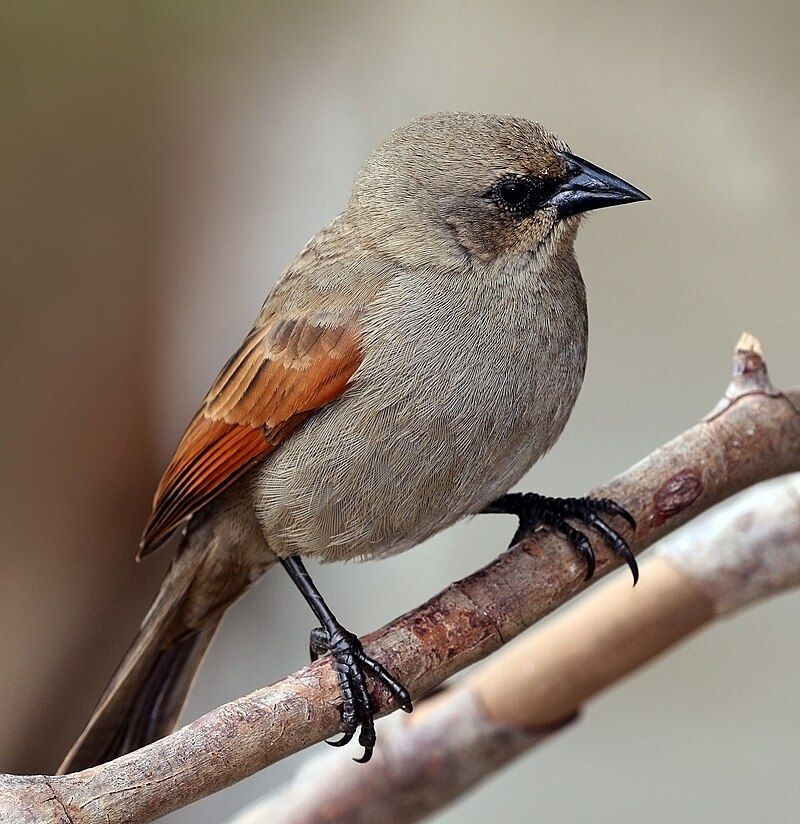
The grayish baywing is a species of bird belonging to the family Icteridae. It was previously referred to as the bay-winged cowbird. This bird is currently placed in the genus Agelaioides, although historically it has been placed in the genus Molothrus.
This bird is a small passerine, usually measuring between 15-17 cm in length. It has a grayish-brown body, with lighter underparts and a darker head. Its wings are a mix of black, brown and white, and its tail is tipped with white.
The grayish baywing is found mainly in the Caribbean, Central America and South America, where it lives in open grasslands, savannas and agricultural areas. It feeds mainly on insects, spiders and other small invertebrates, as well as some seeds and fruit.
It has a wide range of vocalizations, including a harsh whistling sound and a series of low-pitched notes. It is an active bird, often seen flutter-hopping through the vegetation in search of food. The grayish baywing is not considered threatened, and its population is stable.
| Kingdom | Animalia |
| Phylum | Chordata |
| Class | Aves |
| Order | Passeriformes |
| Family | Icteridae |
| Genus | Agelaioides |
| Species | A. badius |
6. Crested Caracara
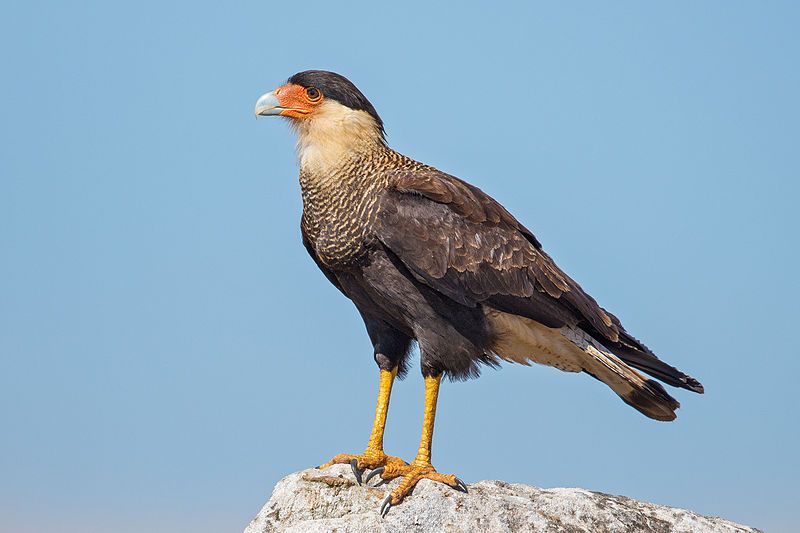
The crested caracara is a large bird of prey belonging to the family Falconidae. It is found throughout Central and South America, from northern Minnesota right down to Tierra del Fuego.
This species is easily distinguished by its long crest of feathers, and its slate-grey feathers. It is a powerful hunter, and its diet consists mainly of small mammals, birds, reptiles, and insects.
It has also been known to scavenge carrion from other predators’ kills. The crested caracara used to be placed in the genus Polyborus, but is now classified in its own genus, Caracara.
It is a fairly adaptable species and has been known to thrive in a variety of habitats, from dry grasslands to tropical forests.
It is also a fairly common species, and can often be seen perched atop power lines or perched atop dead trees. The crested caracara is an important part of the ecosystem.
It helps to keep populations of small mammals and reptiles in balance and also helps to keep scavenging species such as vultures and other birds of prey in check. It is also a popular bird for birdwatchers and is often seen in large flocks in open and semi-open habitats.
| Kingdom | Animalia |
| Phylum | Chordata |
| Class | Aves |
| Order | Falconiformes |
| Family | Falconidae |
| Genus | Caracara |
| Species | C. plancus |
7. Green-barred Woodpecker
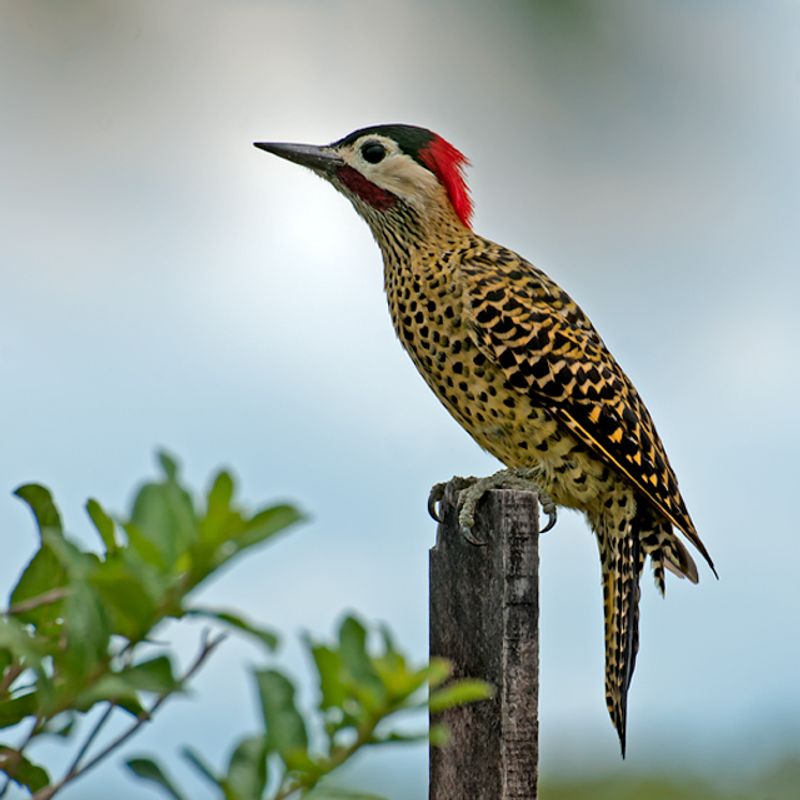
The green-barred woodpecker, also known as the green-barred flicker, is a species of bird belonging to the subfamily Picinae within the woodpecker family, Picidae.
This species of bird can be found in a variety of countries in South America, including Argentina, Bolivia, Brazil, Paraguay, and Uruguay. The green-barred woodpecker is a medium-sized bird with a yellowish-green back and a white chest.
Its head is yellowish-brown with black stripes and its wings are barred with green. The green-barred woodpecker forages for food on the ground, typically on insects, larvae, and other invertebrates. It also occasionally eats fruits and nuts.
It is a social species and often can be found in flocks. The green-barred woodpecker is considered to be an important species in the region, as it helps to control insect populations and is an important seed disperser.
| Kingdom | Animalia |
| Phylum | Chordata |
| Class | Aves |
| Order | Piciformes |
| Family | Picidae |
| Genus | Colaptes |
| Species | C. melanochloros |
8. Red-crested Cardinal
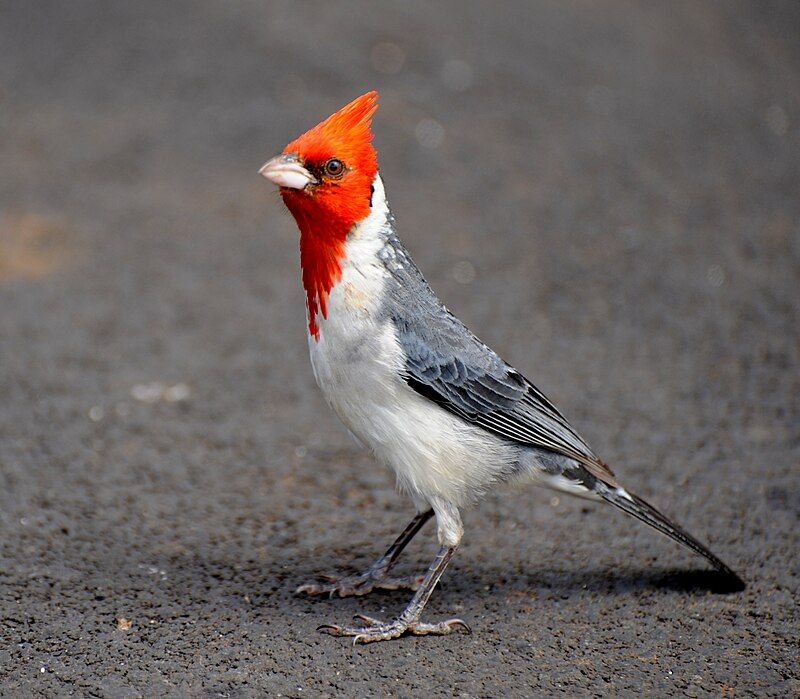
The red-crested cardinal is a species of songbird belonging to the family of tanagers. It is not closely related to the true cardinal family, however, it is often referred to as the Brazilian cardinal.
This colorful and vibrant bird is native to South America, particularly in Brazil, Uruguay, and Paraguay. It has a conspicuous red crest and is easily recognizable due to its distinct coloring. The red-crested cardinal is a small bird, usually measuring around 6 inches in length.
It has a grey-brown back and wings, with a yellow underside and a bright red crest on its head. It also has a black mask around its eyes and a thin yellow stripe above its beak.
The yellow-orange beak is short and slightly curved. This species of bird is usually found in open woodlands, scrubland, and gardens. It feeds on small insects, berries, and other fruits.
It is an active bird and can often be heard singing its distinctive song. The red-crested cardinal is an important species in its habitat and is a keystone species in its ecosystem. It helps to control the population of insects, which in turn helps to keep plant species healthy.
It is also an important food source for other birds and mammals. Overall, the red-crested cardinal is an important species in its environment. It is an attractive bird that is easily identifiable, and its distinctive song makes it a pleasure to hear in the garden or in the wild.
| Kingdom | Animalia |
| Phylum | Chordata |
| Class | Aves |
| Order | Passeriformes |
| Family | Thraupidae |
| Genus | Paroaria |
| Species | P. coronata |
9. Narrow-billed Woodcreeper
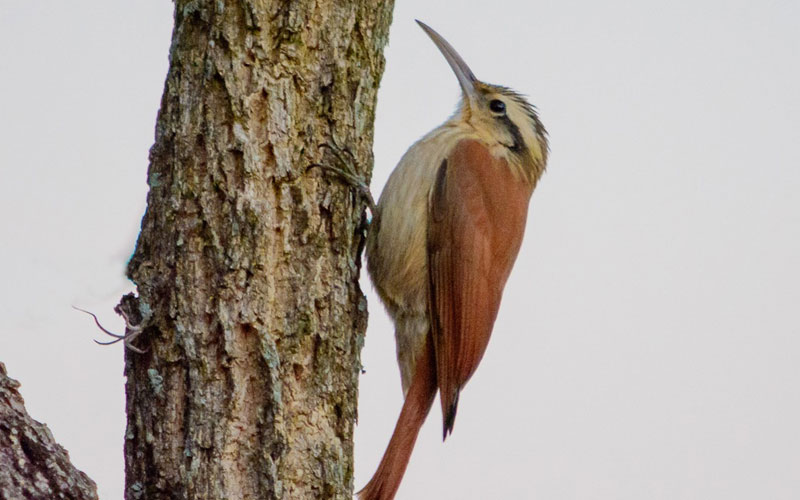
The Narrow-billed Woodcreeper is a type of bird from the ovenbird family, Furnariidae. It is part of the subfamily Dendrocolaptinae, which is a group of birds that includes woodcreepers, treecreepers, and allies.
This species of bird is native to South America and can be found in Argentina, Bolivia, Brazil, Paraguay, Suriname, and Uruguay. The Narrow-billed Woodcreeper has a narrow, pointed bill, and is usually found in forests or woodlands.
It is usually found in pairs or small groups and feeds mainly on insects, spiders, and other small invertebrates. It also eats seeds and nuts.
It is a very active bird and is often seen foraging on tree trunks and branches, often using its bill to probe into crevices. The Narrow-billed Woodcreeper is an important species for local ecosystems, as it helps to control insect populations and disperse seeds.
It is also a popular bird amongst birdwatchers, as it is a relatively easy species to spot.
| Kingdom | Animalia |
| Phylum | Chordata |
| Class | Aves |
| Order | Passeriformes |
| Family | Furnariidae |
| Genus | Lepidocolaptes |
| Species | L. angustirostris |
10. Great Kiskadee
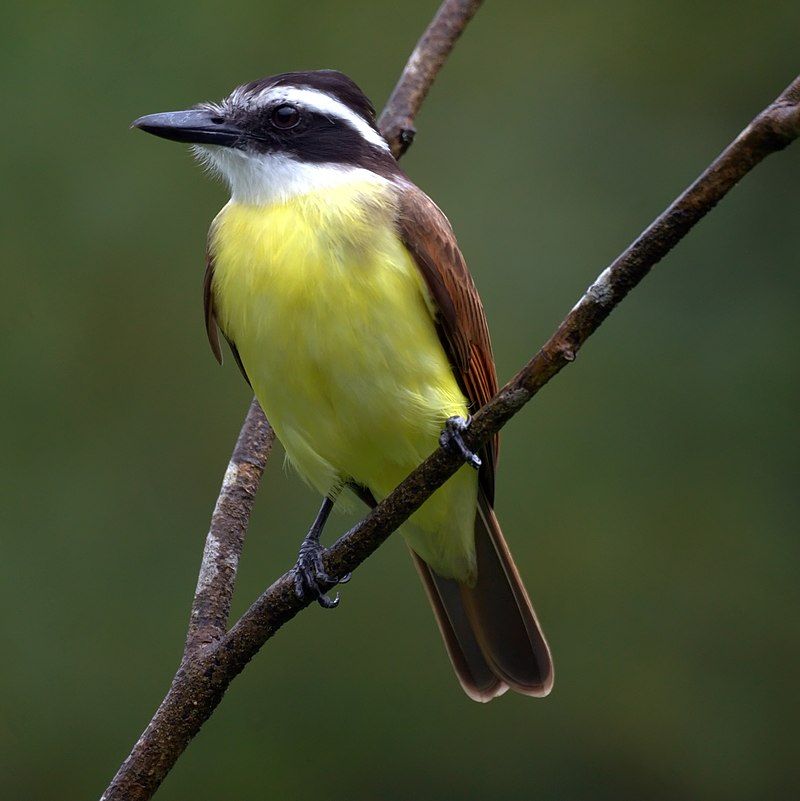
The great kiskadee is a type of passerine bird that belongs to the family Tyrannidae. It is the only member of its genus, Pitangus, and is known by different names in different countries: bem-te-vi in Brazil, pitogue in Paraguay and benteveo in Argentina.
The great kiskadee typically inhabits open woodlands with tall trees such as cultivation and areas around human habitation. It is an adaptable bird and is not afraid to nest close to humans, making it a popular bird in many countries.
It is an omnivore and will eat both insects and fruits and is known for its loud and distinct call. The great kiskadee is an important part of the ecosystem, helping to control insect populations and dispersing fruit seeds.
It is also a popular bird of prey, and its size and striking colors make it an attractive species for bird watchers.
| Kingdom | Animalia |
| Phylum | Chordata |
| Class | Aves |
| Order | Passeriformes |
| Family | Tyrannidae |
| Genus | Pitangus |
| Species | P. sulphuratus |
11. Sayaca tanager
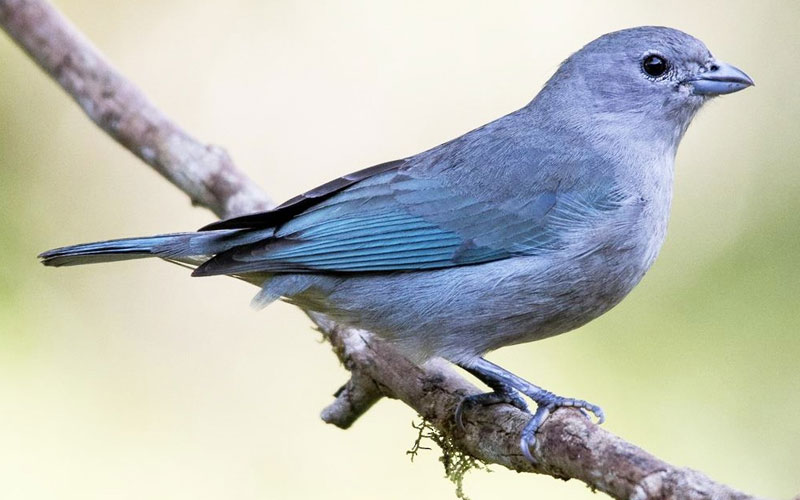
The Sayaca Tanager is a species of bird that belongs to the Thraupidae family, commonly known as the Tanager family. It is found throughout northeastern, central, and southeastern Brazil, as well as Bolivia, Paraguay, Uruguay, and northeastern Argentina.
This species of bird is a common resident in these areas, meaning that it can be seen throughout the year in its natural habitat. The Sayaca Tanager is a medium-sized bird, with a length of approximately 11 cm and a wingspan of up to 25 cm.
It has a greenish-yellow body, a blue head, and a black bill. Its tail is relatively short and its legs are usually a brownish-grey color.
The male and female of this species are very similar in appearance, although the male has a more intense yellowish-green coloration. The Sayaca Tanager is a sociable bird and often appears in large flocks.
Its diet consists mostly of seeds, fruits, and insects, which it obtains by foraging among the trees and shrubs. It also visits bird feeders in some areas. The Sayaca Tanager is usually seen near water, where it searches for food and drinks.
It can also be found in open areas such as pastures and parks. The Sayaca Tanager is a fairly common species and is not considered threatened. However, its population is declining due to habitat destruction and degradation.
Conservation efforts are needed to ensure that this species continues to thrive in its natural habitat.
| Kingdom | Animalia |
| Phylum | Chordata |
| Class | Aves |
| Order | Passeriformes |
| Family | Thraupidae |
| Genus | Thraupis |
| Species | T. sayaca |
12. Masked Gnatcatcher
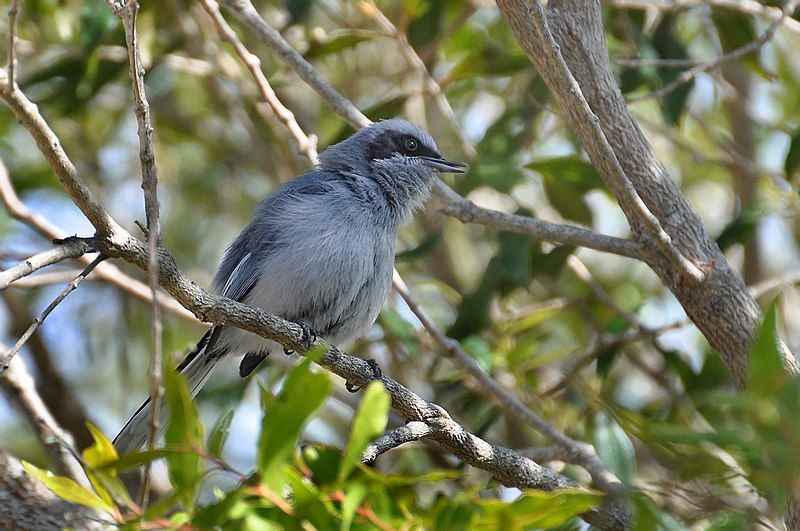
The masked gnatcatcher is a species of small songbird belonging to the family Polioptilidae. This species is mainly found in South America, in the countries of Argentina, Bolivia, Brazil, Paraguay, and Uruguay.
The masked gnatcatcher has a very distinctive appearance, with its small size and greyish-brown plumage. It has a black mask across its eyes, which makes it easily recognizable.
The masked gnatcatcher is mainly found in grassy areas, swamps, and wet meadows, and is known to be very active during the day. It feeds on insects, larvae, and other small invertebrates, and will sometimes eat fruits and seeds.
The masked gnatcatcher is an important part of its natural ecosystem, as it helps to control insect populations and maintains the balance of the environment.
| Kingdom | Animalia |
| Phylum | Chordata |
| Class | Aves |
| Order | Passeriformes |
| Family | Polioptilidae |
| Genus | Polioptila |
| Species | P. dumicola |
13. Roadside Hawk
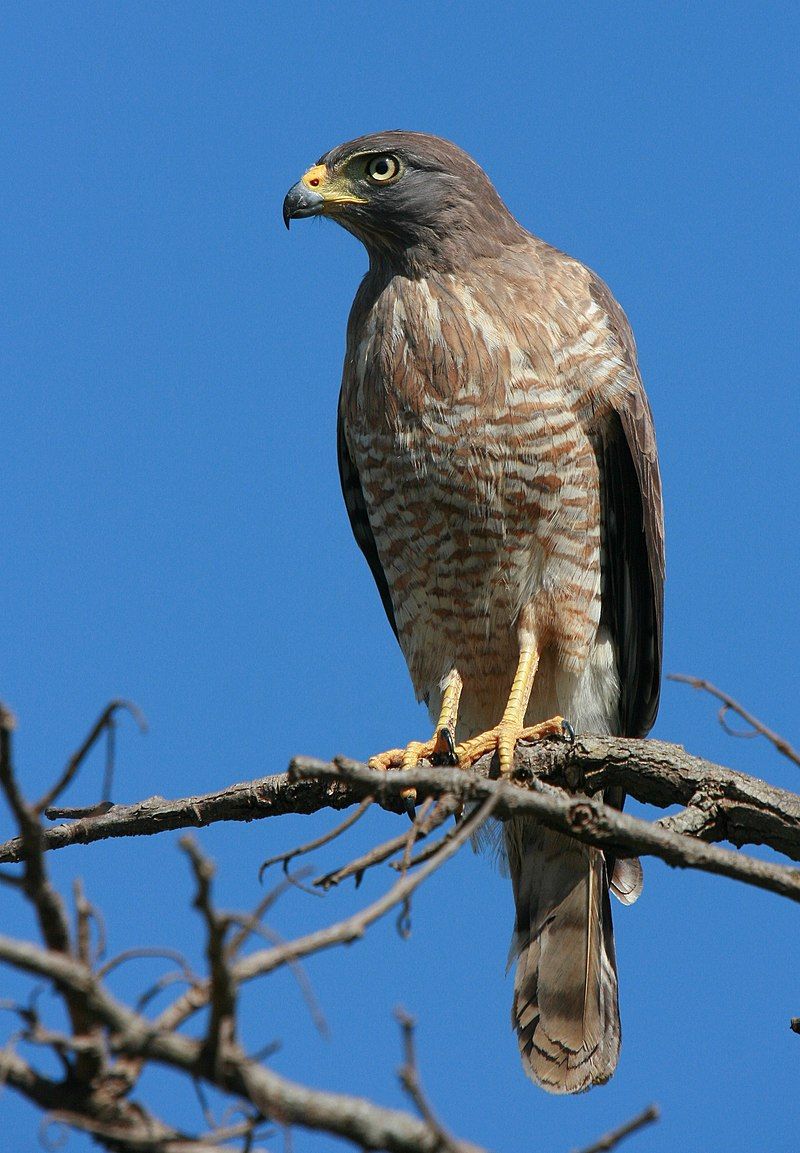
The Roadside Hawk is a species of bird of prey found across the Americas. It is a relatively small raptor, most closely related to the Buteo genus. However, the Roadside Hawk now has its own monotypic genus, Rupornis.
This species is incredibly vocal and is often the most common raptor in its range. There are many subspecies of the Roadside Hawk, each with its own unique characteristics and adaptations. These range from the coloration of the feathers to slight changes in behavior.
Despite the differences between the subspecies, all Roadside Hawks share a common ancestry and are found across the Americas.
| Kingdom | Animalia |
| Phylum | Chordata |
| Class | Aves |
| Order | Accipitriformes |
| Family | Accipitridae |
| Genus | Rupornis |
| Species | R. magnirostris |
14. Brazilian Teal
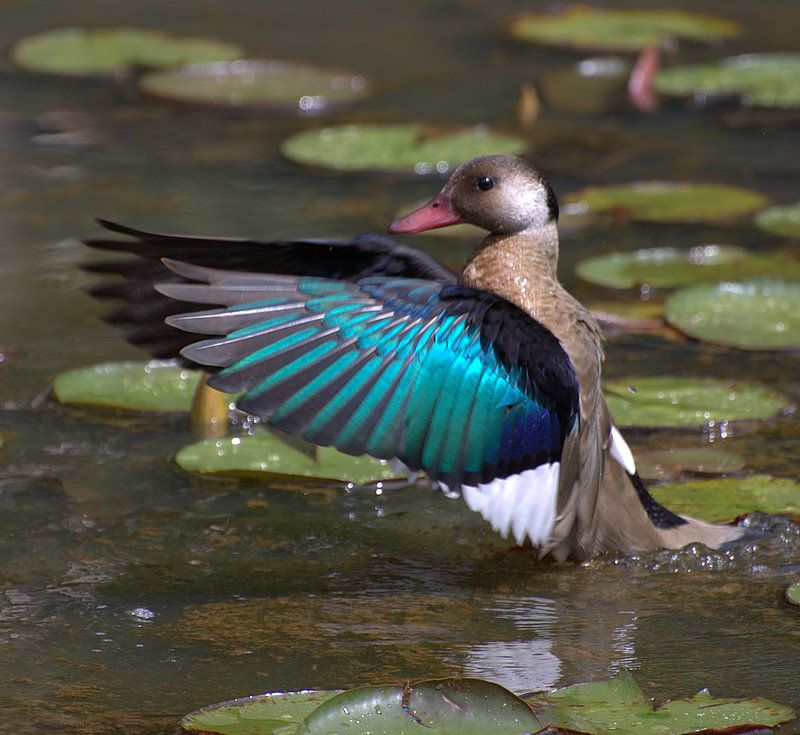
The Brazilian teal, also known as the Brazilian duck, is a species of duck that is unique in its own genus, Amazonetta. It is native to eastern South America and is found throughout the continent in many different habitats.
It is a medium-sized duck, with males typically weighing up to 1.2 kg and females up to 0.9 kg. The plumage of the Brazilian teal is predominantly brown, with a white chest and abdomen, and a light blue bill.
The wings are also blue-gray in color, with a white stripe running along the edge. The Brazilian teal is an omnivorous species, primarily feeding on aquatic vegetation, insects, and crustaceans. It is also known to eat some small fish and amphibians.
During the breeding season, the Brazilian teal forms small flocks that can be seen foraging in shallow waters. The female will lay her eggs in a nest on the ground, concealed among vegetation.
The eggs are then incubated by both parents for around 24 days before hatching. The Brazilian teal is an important species for waterfowl hunting in many parts of South America.
It is also an important species for ecotourism, as it is one of the most attractive waterfowl in the region. Due to its wide distribution and large population, the Brazilian teal is currently classified as a species of Least Concern by the IUCN.
| Kingdom | Animalia |
| Phylum | Chordata |
| Class | Aves |
| Order | Anseriformes |
| Family | Anatidae |
| Genus | Amazonetta |
| Species | A. brasiliensis |
15. Brown-chested Martin
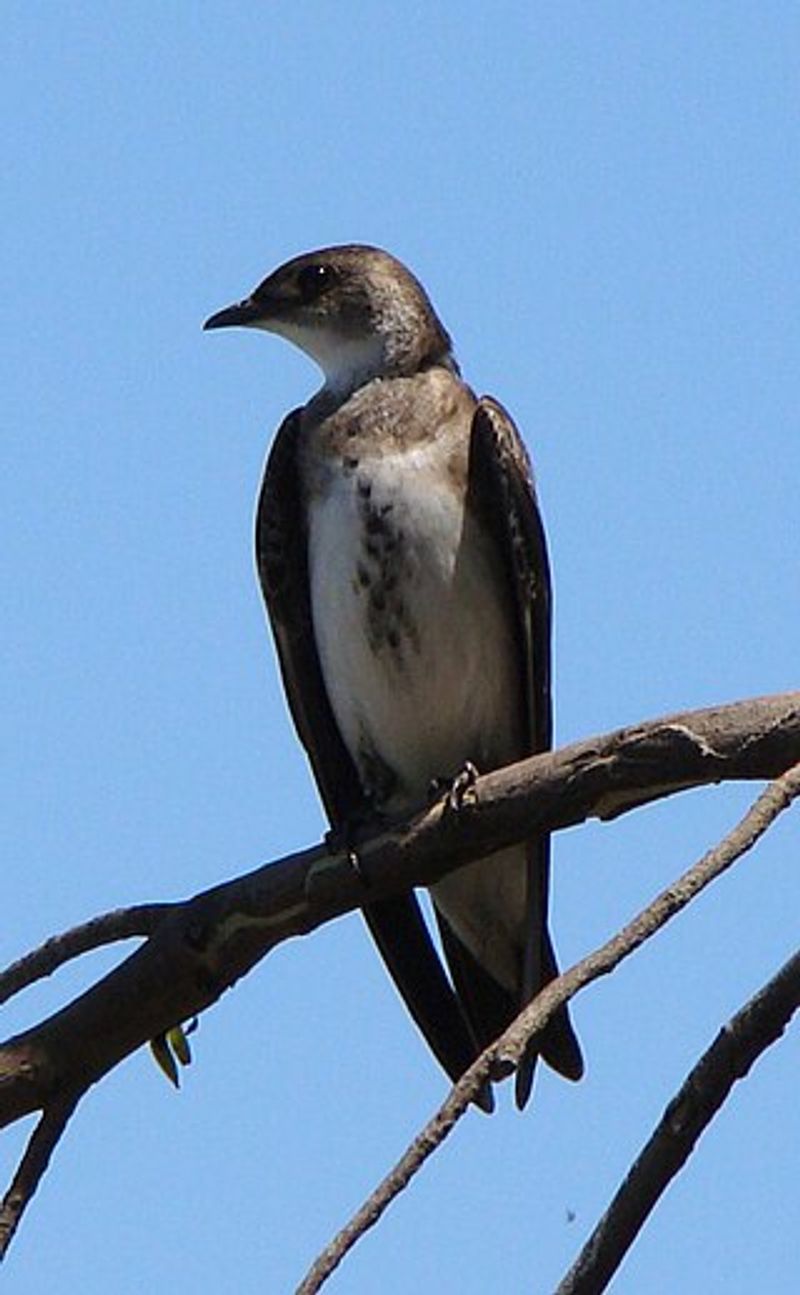
The brown-chested martin is a species of passerine bird found mainly in South America. It belongs to the swallow family, which is known for its aerodynamic and agile flying abilities.
These birds are found in the countries of Argentina, Bolivia, Brazil, Chile, Colombia, Costa Rica, Ecuador, French Guiana, Guyana, Panama, Paraguay, Peru, Suriname, Uruguay, and Venezuela. These birds are small, around 15 cm in length, with a wingspan of up to 25 cm.
Their brown chest is their most prominent feature, and they also have a forked tail. They have olive-brown upperparts and a white throat and belly.
Their flight is fast and direct, and they can be seen swooping after insects. Brown-chested martins prefer a wide variety of habitats, such as woodlands, savannas, wetlands, and even urban areas. They are usually found in pairs or small flocks.
Their diet consists of mainly insects, but they also feed on fruits and nectar. They are known to be aggressive in defending their nests. The brown-chested martin is an important species for its wide range and the various habitats it uses.
It is also considered an indicator species, as its presence can be used to measure the health of its environment. As such, its conservation is of utmost importance.
| Kingdom | Animalia |
| Phylum | Chordata |
| Class | Aves |
| Order | Passeriformes |
| Family | Hirundinidae |
| Genus | Progne |
| Species | P. tapera |
16. Brown-and-yellow Marshbird
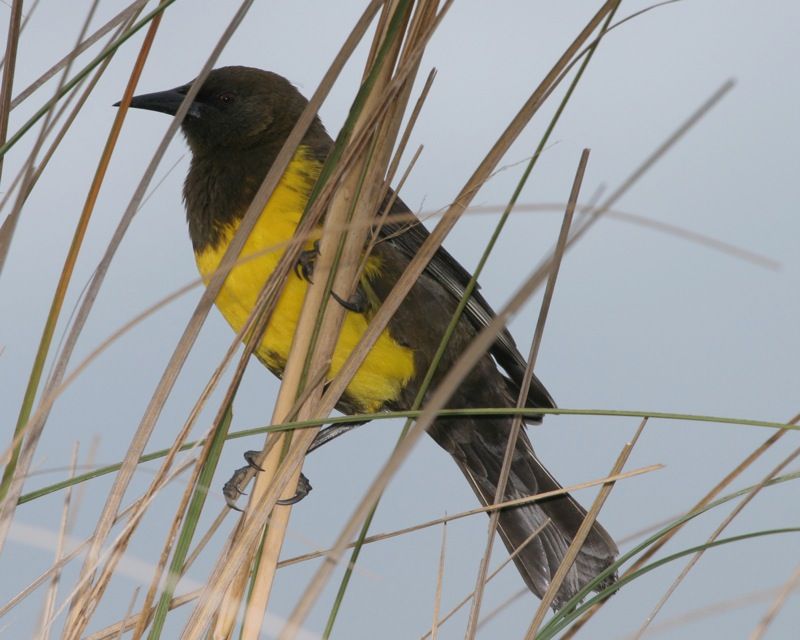
The brown-and-yellow marshbird is a species of bird found in South America. It belongs to the family Icteridae, which includes many species of passerine birds, or perching birds, found in the Americas.
The marshbird is found in the Pampas region of Argentina, Uruguay, and southern Brazil, up to the Paraguayan border and Rio Grande do Sul. Its natural habitats are swamps and pastureland, where it can find plenty of food and shelter.
The marshbird is a medium-sized bird, typically about 15 cm in length. Its plumage is mostly brown and yellow, with black streaks on its wings and body. Its diet consists mainly of insects, larvae, and small invertebrates found in wetlands. It also feeds on seeds and berries.
The marshbird is a vocal species and its call is a high-pitched whirring sound. The marshbird is an important species in its range, as it helps to control insect populations in its habitat and also contributes to the overall diversity of bird species in the region.
| Kingdom | Animalia |
| Phylum | Chordata |
| Class | Aves |
| Order | Passeriformes |
| Family | Icteridae |
| Genus | Pseudoleistes |
| Species | P. virescens |
17. Golden-billed Saltator
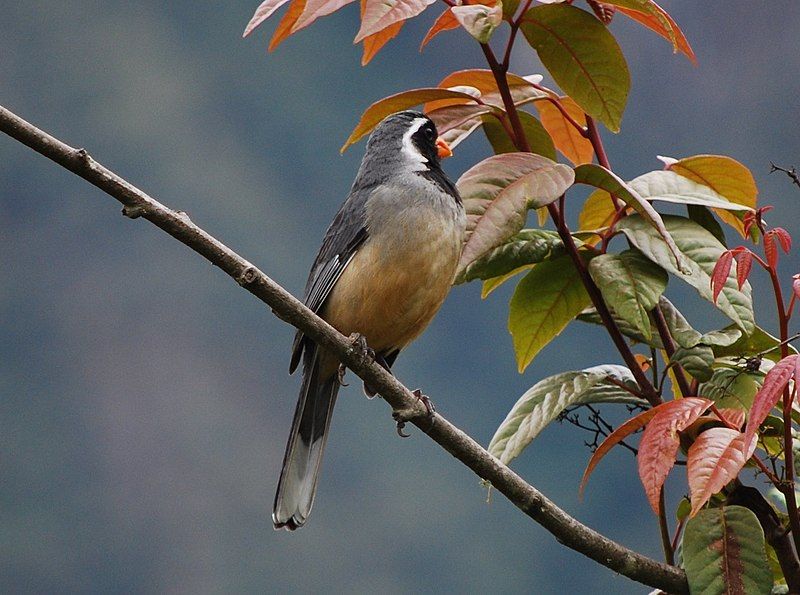
The Golden-billed Saltator is a species of bird from the family Thraupidae. This species is found in a wide range of countries throughout South America, including Argentina, Bolivia, Brazil, Chile, Paraguay, Peru, and Uruguay.
It has also been observed in the region of the Southern Pantanal, along the Paraguay River. The Golden-billed Saltator is one of the most widely distributed passerine birds in South America and is a common sight in many of the countries it inhabits.
It is a medium-sized bird, with a length of around 16 cm and a wingspan of 22 cm. Its plumage is mainly grey and white, with a yellow bill and orange legs. Its diet consists mainly of insects, fruits, and seeds. The Golden-billed Saltator has an interesting mating pattern.
Unlike many other birds, it is monogamous, meaning it has just one mate for life. During the breeding season, the pair builds a cup-shaped nest in a tree or shrub, and the female usually lays two to four eggs.
The young are tended to by both parents until they are able to fly and leave the nest. The Golden-billed Saltator is an important part of the ecosystem in South America.
It helps to control insect populations, and its diet of fruits and seeds helps to disperse the seeds of many plants. It is also an important food source for many other bird species and is an important part of the food web in South America.
| Kingdom | Animalia |
| Phylum | Chordata |
| Class | Aves |
| Order | Passeriformes |
| Family | Thraupidae |
| Genus | Saltator |
| Species | S. aurantiirostris |
18. Black-capped Warbling Finch
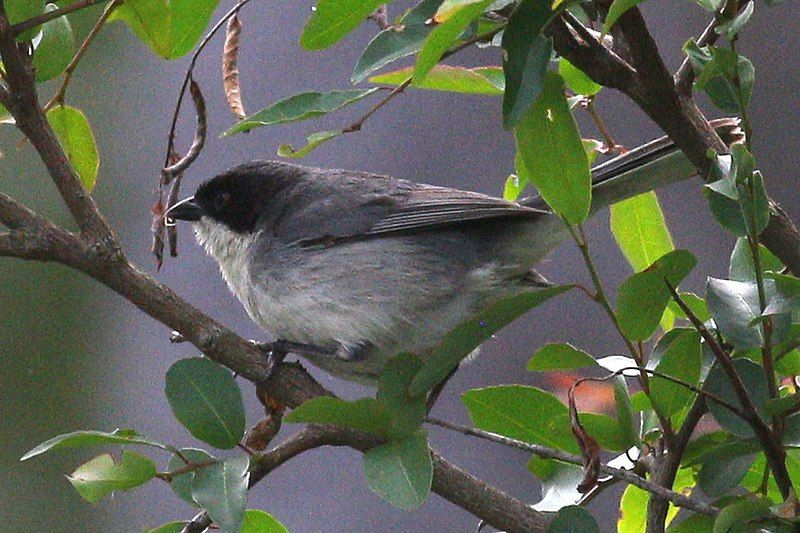
The black-capped warbling finch is a species of bird in the family Thraupidae, which is found in South American countries such as Argentina, Bolivia, Brazil, Paraguay, and western Uruguay.
This bird species prefers to live in dry habitats and is rarely seen in wetter environments. Its natural habitats include subtropical or tropical dry forests, subtropical or tropical dry shrubland, and subtropical or tropical high-altitude shrubland.
Dry forests are especially important for the black-capped warbling finch as they provide the food and shelter that it needs to survive. These forests are characterized by a dry climate and sparse vegetation, with trees and shrubs often being the dominant vegetation.
Dry shrublands are similar to dry forests but are composed of shrubs and bushes instead of trees. High-altitude shrublands are also important habitats for the black-capped warbling finch, as they provide a higher elevation and cooler temperatures than the other habitats.
All of these habitats are essential to the survival of the black-capped warbling finch, and they provide the bird with the necessary resources to thrive and reproduce.
| Kingdom | Animalia |
| Phylum | Chordata |
| Class | Aves |
| Order | Passeriformes |
| Family | Thraupidae |
| Genus | Microspingus |
| Species | M. melanoleucus |
19. Yellow-chinned Spinetail
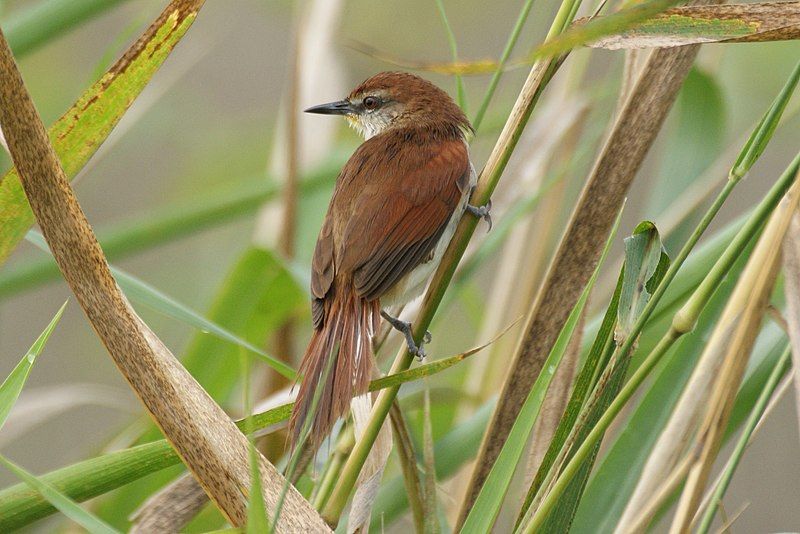
The yellow-chinned spinetail is a type of passerine bird found in the tropical regions of the New World. This bird can be found in places such as Trinidad and Colombia, extending south to Argentina and Uruguay.
It belongs to the South American ovenbird family, called Furnariidae.
This is a large group of over 200 species of birds, known for their ability to build oven-shaped nests.The yellow-chinned spinetail is a medium-sized bird, about 12–14 cm in length, with a slender body and long tail.
Its plumage is grey-brown in color, with a yellow chin and throat. It has a long, pointed bill and a long, black tail with white tips.
Its diet consists mainly of insects, but it will also eat small fruits and berries. The yellow-chinned spinetail is found in open forests, woodlands, and savannas, and can be found at elevations of up to 2,000 m. It is an active bird and is usually seen in pairs or small flocks.
During the breeding season, the male will perform a courtship flight, displaying its yellow chin. The nest is usually built in a tree or bush, and consists of a cup of grass and leaves. The female will lay two to three eggs, which are incubated for about two weeks.
Both parents help to feed the chicks until they fledge at around three weeks old. Overall, the yellow-chinned spinetail is a common bird in its range and is not considered to be threatened.
Its population is generally stable, and it is listed as a species of least concern by the International Union for Conservation of Nature.
| Kingdom | Animalia |
| Phylum | Chordata |
| Class | Aves |
| Order | Passeriformes |
| Family | Furnariidae |
| Genus | Certhiaxis |
| Species | C. cinnamomeus |
20. Spotted Nothura
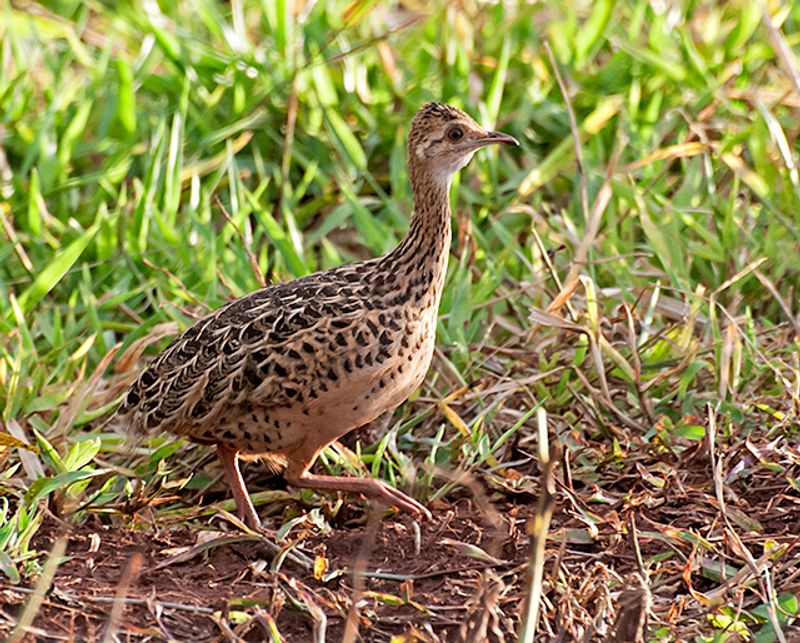
The spotted nothura is a species of tinamou, a type of bird native to South America. This bird is most commonly found in areas of grassy habitats in the eastern and southern regions of Brazil, Paraguay, Uruguay, and eastern and northern Argentina.
It has a distinctive black and white spotted pattern on its feathers, allowing it to blend in with its natural habitat and avoid predators. The spotted nothura feeds on a variety of items, including insects, snails, small lizards, and plants.
It is usually seen alone or in small groups and prefers to stay close to the ground. The species is listed as “Least Concern” by the International Union for Conservation of Nature due to its wide distribution and its large population size.
| Kingdom | Animalia |
| Phylum | Chordata |
| Class | Aves |
| Order | Tinamiformes |
| Family | Tinamidae |
| Genus | Nothura |
| Species | N. maculosa |
21. Yellow Cardinal
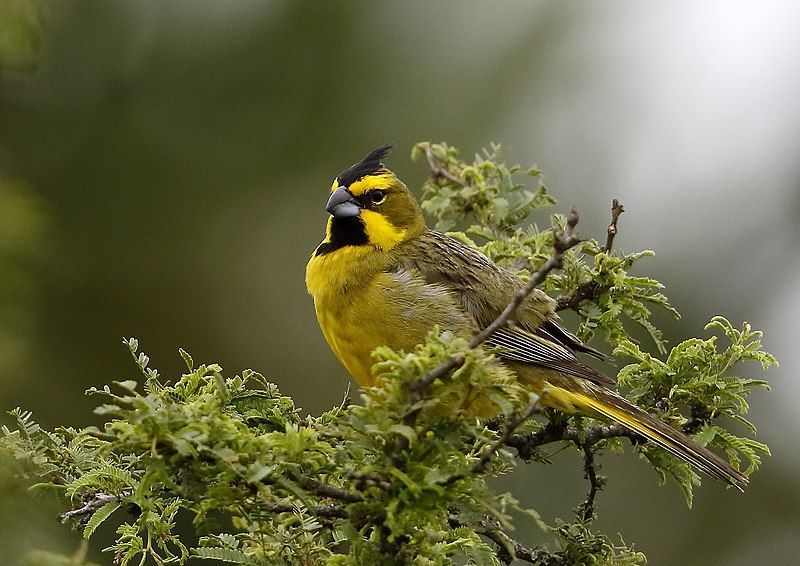
The yellow cardinal is a beautiful species of bird that is found only in South America, in the family Thraupidae. It is the only member of its unique genus, Gubernatrix, making it a very special species.
The yellow cardinal is a rare bird, with its habitat stretching across only one continent. Its bright yellow coloring and unique appearance make it stand out among other birds of its family.
The yellow cardinal is a sight to behold, and its rarity makes it all the more special. Its one-of-a-kind status in the bird world gives it a sense of mystery and intrigue. The yellow cardinal is a truly remarkable species that is sure to captivate any bird enthusiast.
| Kingdom | Animalia |
| Phylum | Chordata |
| Class | Aves |
| Order | Passeriformes |
| Family | Thraupidae |
| Genus | Gubernatrix |
| Species | G. cristata |
22. Rufescent Tiger Heron
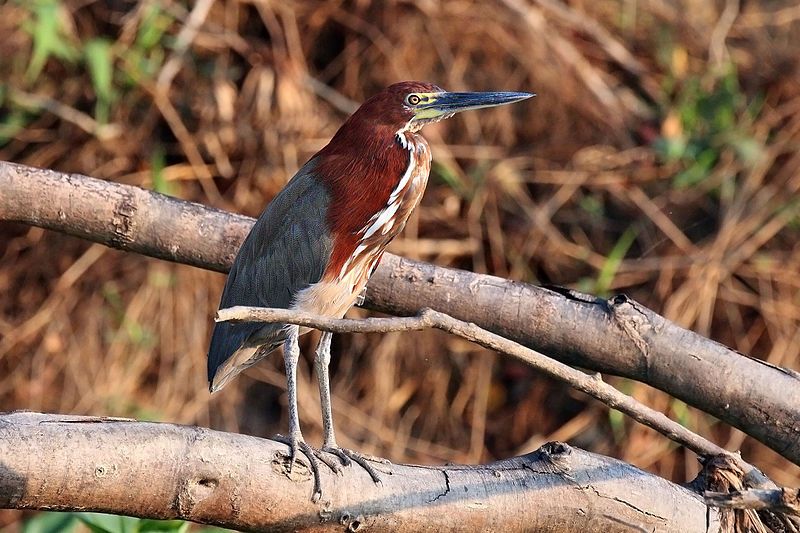
The Rufescent Tiger-Heron is a species of long-legged wading bird found in many parts of Central and South America. It is part of the Ardeidae family, which includes other herons, egrets, and bitterns.
The Rufescent Tiger Heron is a medium-sized wading bird, with a body length ranging from about 60 to 75 centimeters. It has a brown back and wings, and a gray head and neck, with a white throat and yellowish-green facial skin.
Its chest is white, and its belly and legs are orange-brown. The male and female look similar, although the male is slightly larger. The Rufescent Tiger-Heron can be found in a variety of wetland habitats, including marshes, swamps, lakes, ponds, and flooded fields.
It is usually found in shallow, slow-moving water, where it feeds on fish, amphibians, crustaceans, and other aquatic animals. It may also feed on small mammals, reptiles, and insects.
During the breeding season, the Rufescent Tiger Heron builds a large nest platform in a tree or bush, usually close to water. It is a solitary nester, and the female lays two to three eggs, which are incubated for about three weeks.
Both parents take part in the incubation and care of the young. The Rufescent Tiger-Heron is an important species of wetland bird, and it is listed as Least Concern on the IUCN Red List. Its population is considered stable, and it is not currently threatened.
However, it is vulnerable to habitat loss, pollution, and disturbance from human activities. Conservation efforts are underway to protect and conserve this species and its habitat.
| Kingdom | Animalia |
| Phylum | Chordata |
| Class | Aves |
| Order | Pelecaniformes |
| Family | Ardeidae |
| Genus | Tigrisoma |
| Species | T. lineatum |
23. White-barred Piculet
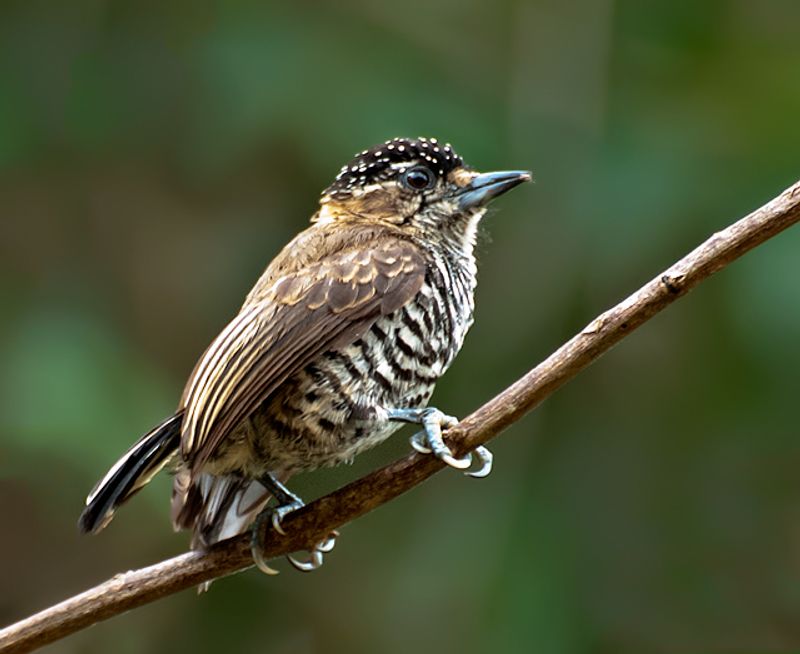
The white-barred piculet is a species of small bird that is part of the subfamily Picumninae, which is part of the woodpecker family Picidae.
This species of bird is found in many parts of South America, including Argentina, Bolivia, Brazil, French Guiana, Guyana, Paraguay, and Uruguay. It is typically a very small bird, with a length of only 4.7-5.1 inches, and a wingspan of only 7-8.2 inches.
The distinctive plumage of the white-barred piculet consists of a black head and back, white streaks across the face and neck, white bars on the wings and tail, and a yellow-olive belly.
This species of bird is typically found in subtropical forests and woodlands, where they feed on insects, spiders, and other small invertebrates.
They are usually found in pairs or small groups and can be quite active during the day, flitting through the canopy in search of food.
| Kingdom | Animalia |
| Phylum | Chordata |
| Class | Aves |
| Order | Piciformes |
| Family | Picidae |
| Genus | Picumnus |
| Species | P. cirratus |
24. Campo Flicker
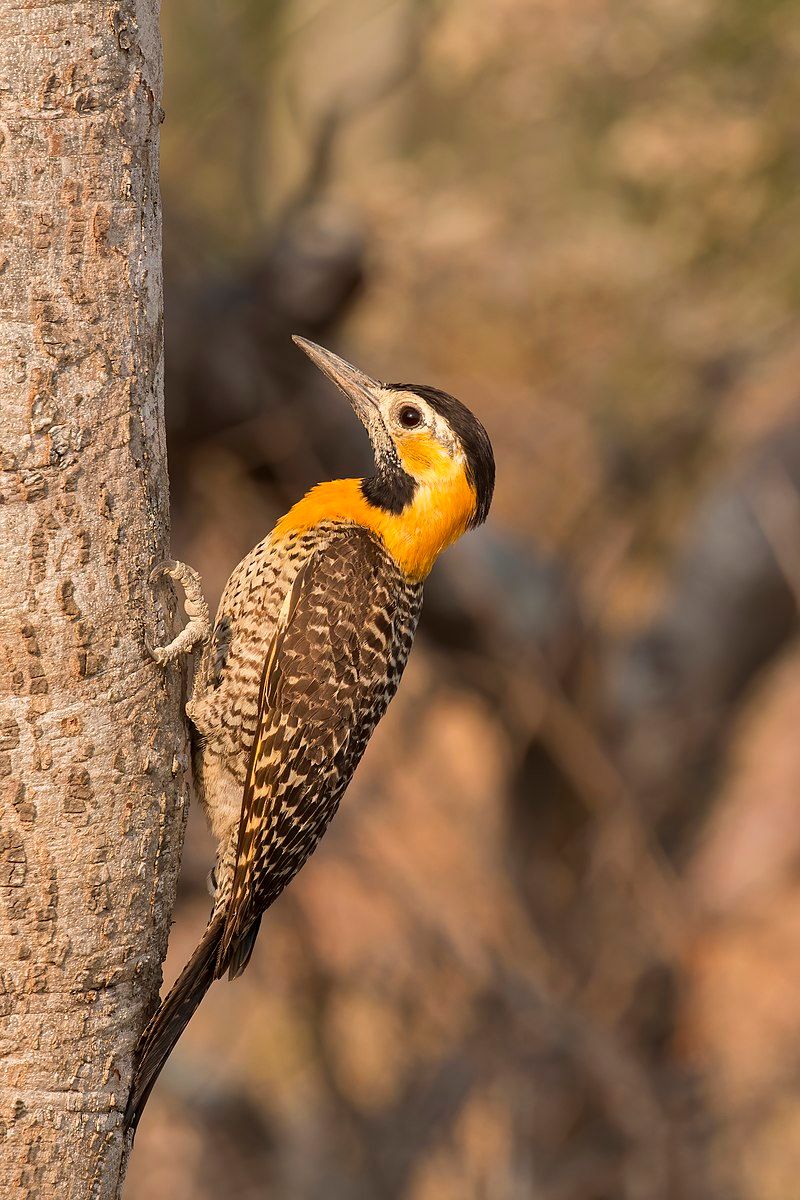
The campo flicker is a species of bird native to South America. It is a member of the subfamily Picinae of the woodpecker family Picidae, which is comprised of over 230 species.
The campo flicker can be found in Argentina, Bolivia, Brazil, Paraguay, Suriname, and Uruguay, where it inhabits a variety of habitats including grasslands, savannas, woodlands, and mangroves.
The campo flicker is typically olive-green in color, with yellow and black stripes on its wings and tail. It has a black and white barred pattern on its back and rump, and a white throat, forehead, and crown.
This species of bird is omnivorous, feeding on insects, berries, and fruit. The campo flicker is known for its loud, distinctive call, and is often seen in pairs or small groups.
| Kingdom | Animalia |
| Phylum | Chordata |
| Class | Aves |
| Order | Piciformes |
| Family | Picidae |
| Genus | Colaptes |
| Species | C. campestris |
25. Rufous-bellied Thrush
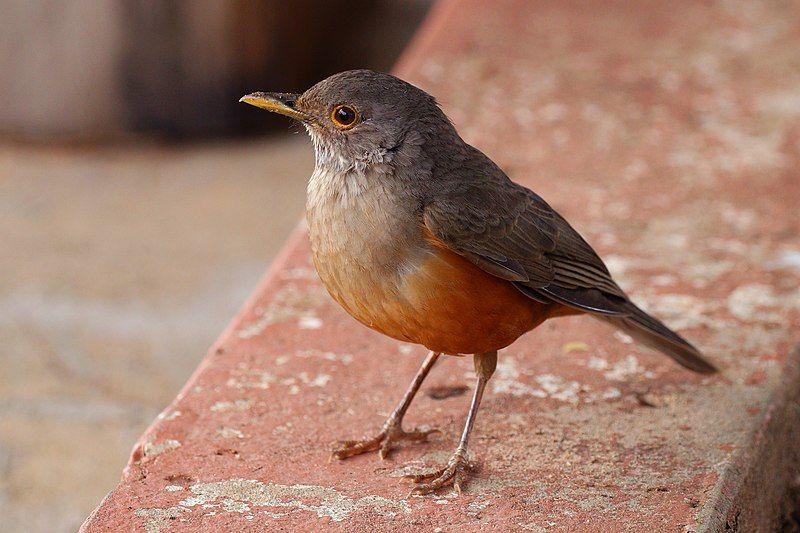
The rufous-bellied thrush is a species of songbird found within the thrush family. This species has a wide range of distribution across various regions of South America.
They can be found in most of east and southeast Brazil, from the Maranhão state south to Rio Grande do Sul, as well as in Bolivia, Paraguay, Uruguay, and the central regions of Argentina.
The rufous-bellied thrush is an adaptable species, capable of inhabiting both open and closed habitats. This species is fairly common throughout its range. The rufous-bellied thrush is a medium-sized songbird, with a distinctive rusty-brown color on its belly.
It has a buff-colored breast, grayish-brown wings, and a dark gray head. The bill is black and the eyes are a bright yellow. This species is a vocal bird, with a melodious song that is often heard in its range.
The rufous-bellied thrush is an omnivore, feeding on a variety of insects, fruits, and berries. This species is also known to visit bird feeders, where they can pick up seeds and other bits of food. They will forage on the ground and in trees, often in small flocks.
The rufous-bellied thrush is an important species to the ecosystem, playing a role in controlling insect populations and dispersing seeds. The species is also of great value to birdwatchers, as its bright colors and melodic song make it a delight to watch.
| Kingdom | Animalia |
| Phylum | Chordata |
| Class | Aves |
| Order | Passeriformes |
| Family | Turdidae |
| Genus | Turdus |
| Species | T. rufiventris |
26. Solitary Cacique
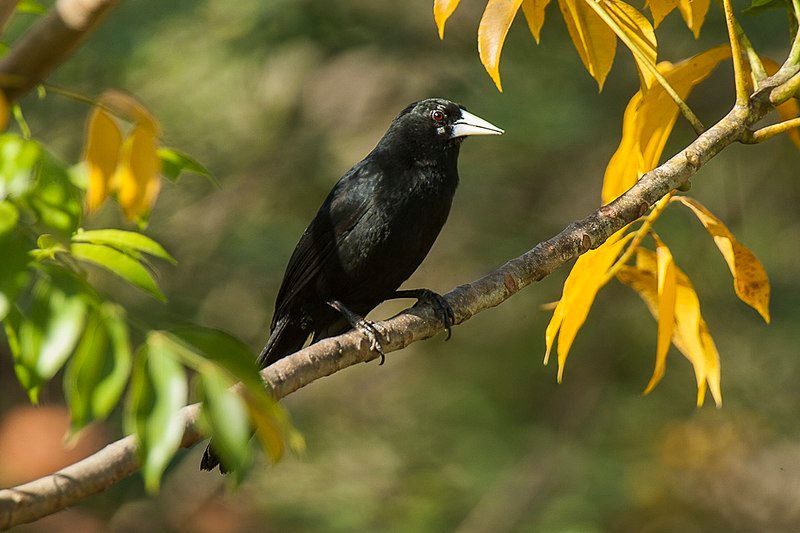
The Solitary Cacique is a species of bird found in the Icteridae family. It is distributed throughout much of South America, being found in Argentina, Bolivia, Brazil, Colombia, Ecuador, Paraguay, Peru, Uruguay, and Venezuela.
This bird is a medium-sized blackbird, and its name derives from the word cacique, which is the Spanish term for a local chief. It is a solitary species, typically seen alone or in small groups. It feeds on insects and fruit and makes its nest in dense vegetation.
This species is not considered threatened, but its population is decreasing due to habitat loss and other human-related activities. With the continued protection of its natural habitat, this species can be preserved and its numbers can be stabilized.
| Kingdom | Animalia |
| Phylum | Chordata |
| Class | Aves |
| Order | Passeriformes |
| Family | Icteridae |
| Genus | Cacicus |
| Species | C. solitarius |
27. Streaked Flycatcher
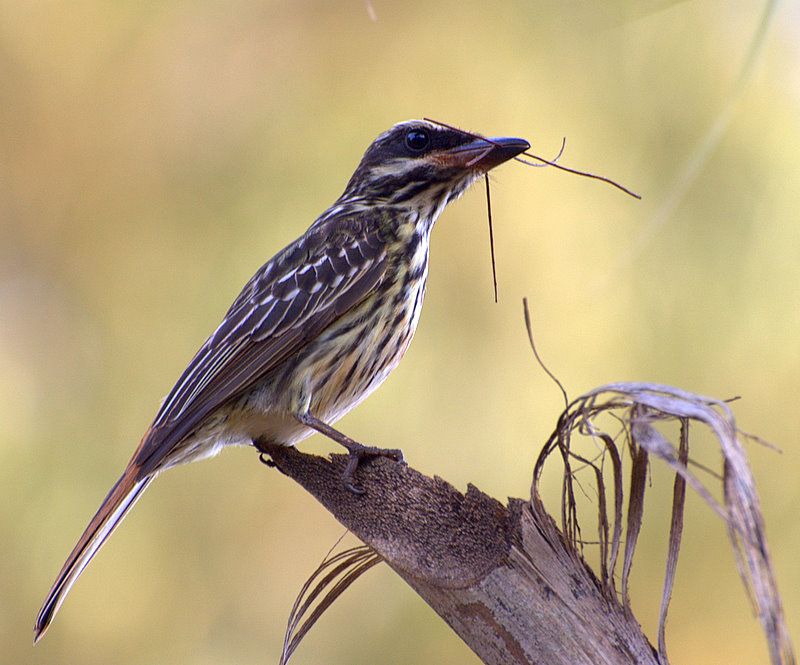
The Streaked Flycatcher is a member of the avian family of birds known as the tyrant flycatchers. It is a passerine bird, meaning that it belongs to the order of birds known as Passeriformes, which includes all of the perching birds commonly referred to as songbirds.
The Streaked Flycatcher is found in the eastern parts of Asia, including China, Mongolia, and Korea, and prefers to inhabit moist areas such as forests, scrubs, and wetlands. Its diet consists mainly of insects, which it catches mid-air with its long bill.
It is a medium-sized bird, measuring around 15 cm in length, and has brownish-grey plumage speckled with white spots. Its wingspan typically measures about 25-28 cm.
The Streaked Flycatcher builds its nest in tree hollows and is typically seen in flocks during the winter season.
| Kingdom | Animalia |
| Phylum | Chordata |
| Class | Aves |
| Order | Passeriformes |
| Family | Tyrannidae |
| Genus | Myiodynastes |
| Species | M. maculatus |
28. Greyish Saltator
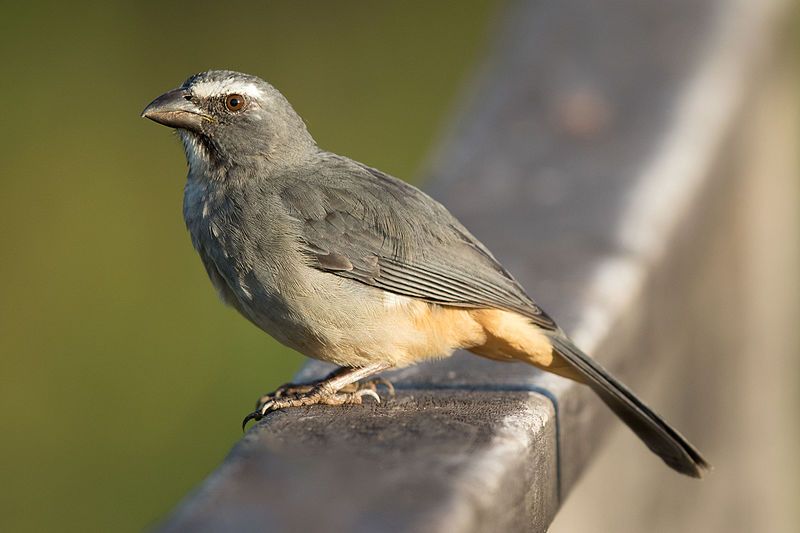
The bluish-grey saltator, also known as the Amazonian grey saltator, is a passerine bird that belongs to the tanager family Thraupidae. This bird is native to South America, where it is found in both tropical and subtropical regions.
Its habitats of choice are semi-open areas, such as savannas, grasslands, woodlands, and scrublands.The bluish-grey saltator is a medium-sized bird, typically measuring around 16 to 17 cm in length and having a wingspan of up to 28 cm.
Its plumage is mainly greyish-blue in color, with black wings and tail, and a white belly. The bill is short and conical, and the legs are pinkish-grey. The diet of the bluish-grey saltator consists mostly of insects and other invertebrates, such as worms and spiders.
It also eats some fruit and seeds, which it often finds while foraging on the ground. This species is usually seen in small flocks, which can be composed of up to dozens of individuals.
They can often be observed perching on low branches or foraging on the ground. The breeding season of the bluish-grey saltator usually starts in September and lasts until November.
The nests are typically located on trees or shrubs and are made of plant fibers and lined with grass, feathers, and other materials.
Both parents are involved in caring for the young, which usually hatch after two weeks of incubation. Overall, the bluish-grey saltator is a widespread species that is common in semi-open habitats throughout South America.
Its population is currently considered to be stable, and it is classified as a species of least concern by the International Union for Conservation of Nature.
| Kingdom | Animalia |
| Phylum | Chordata |
| Class | Aves |
| Order | Passeriformes |
| Family | Thraupidae |
| Genus | Saltator |
| Species | S. coerulescens |
29. White-rumped Swallow
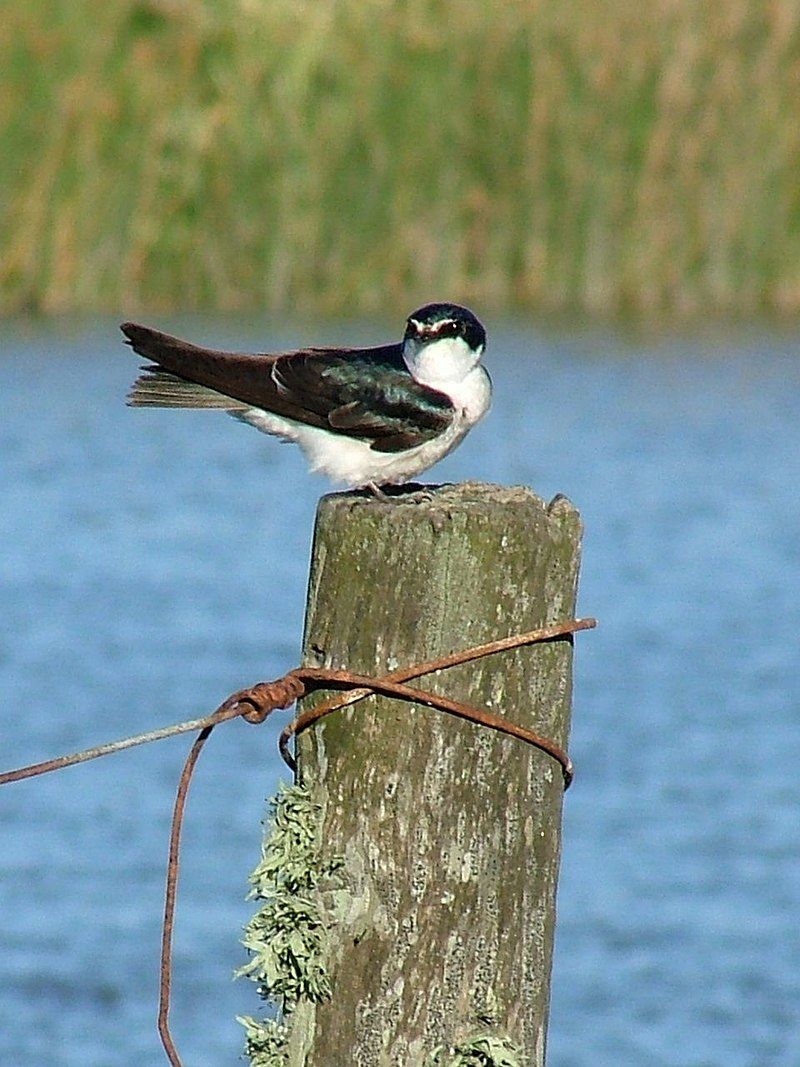
The white-rumped swallow is a species of bird from the family Hirundinidae. It was given its scientific name, or binomial name, by Louis Vieillot, a French ornithologist, in 1817.
For a long time, it was thought to be a subspecies of the Chilean swallow, but it has since been identified as a species in its own right, with no known population variations.
This means that the white-rumped swallow is a monotypic species, meaning that all individuals of this species share the same traits. The white-rumped swallow is found in various locations around the world, including India, China, Japan, and Australia.
It has a white rump, which is the source of its name, and has a blue-black head, a white throat, and a pale brown body. These birds feed mainly on insects, and they can often be seen flitting around in flocks.
They build cup-shaped nests in cliffs and trees, and they lay two to three eggs at a time.
| Kingdom | Animalia |
| Phylum | Chordata |
| Class | Aves |
| Order | Passeriformes |
| Family | Hirundinidae |
| Genus | Tachycineta |
| Species | T. leucorrhoa |
30. White-winged Coot
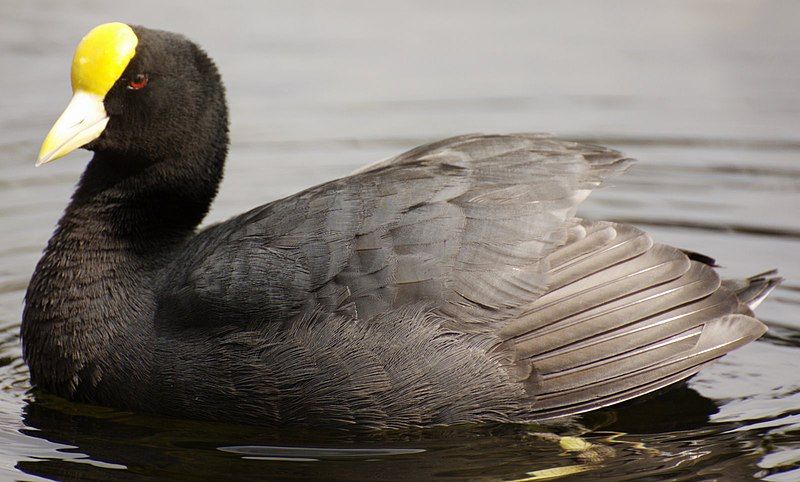
The white-winged coot is a species of bird found in various countries in South America, including Argentina, Bolivia, Brazil, Chile, Paraguay, Uruguay, and the Falkland Islands. It is part of the subfamily Rallinae in the family of birds known as Rallidae.
This particular family, which also includes rails, gallinules, and coots, is known for its unique appearance and behavior. The white-winged coot can be easily identified by its distinctive white wings and black body.
Its wingspan is often around 50 cm and it is approximately 30 cm in length. This species of bird is usually found near shallow water and marshes, where it can feed on algae, aquatic vegetation, insects, and small fish.
The white-winged coot is also known for its loud call, which is similar to a loud croak. The white-winged coot is a migratory bird and it can be found in different countries during different times of the year.
During the winter months, it is usually found in the southern regions of South America, and during the summer months, it can be found in the northern regions.
It has also been observed in the Falkland Islands, which is located in the southwest Atlantic Ocean. The white-winged coot is an important species of bird in South America, and its conservation is essential for the health of its habitats.
This species of bird is a vital part of the local ecosystem, as it helps to keep the water clean and the aquatic vegetation healthy. Therefore, conservation efforts should be implemented to ensure that this species of bird is protected and its population is maintained.
| Kingdom | Animalia |
| Phylum | Chordata |
| Class | Aves |
| Order | Gruiformes |
| Family | Rallidae |
| Genus | Fulica |
| Species | F. leucoptera |
31. Plumbeous Rail
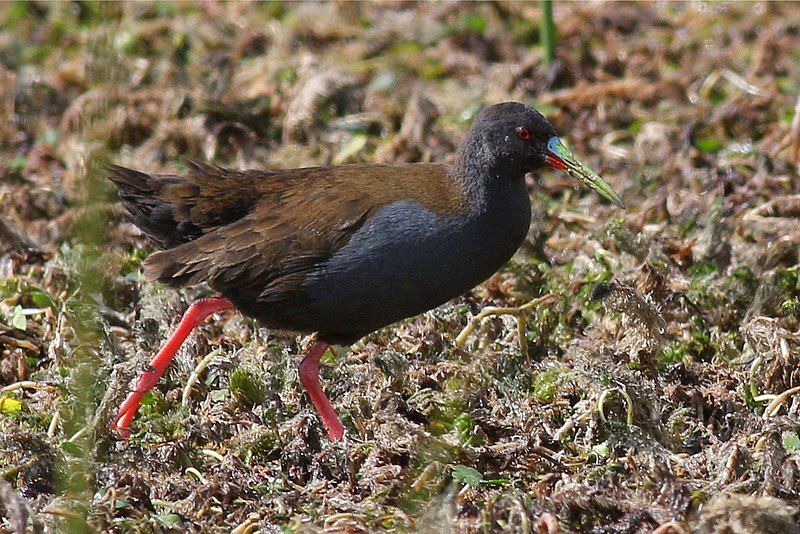
The plumbeous rail is a unique species of bird found throughout South America. It is part of the Rallinae subfamily of the Rallidae family, which includes rail, crake, and coot birds.
This bird can be found in a number of countries in the region, including Argentina, Bolivia, Brazil, Chile, Ecuador, Paraguay, Peru, and Uruguay. The plumbeous rail is a medium-sized bird, typically measuring between 8 and 10 inches in length.
It has a slate grey body, with a white chin and throat, and a distinctive black and white striped head.
Its wings are short and rounded, and its tail is short and squared off. The plumbeous rail is mainly a terrestrial bird, meaning it spends most of its time on the ground looking for food.
It is an omnivorous species, feeding on earthworms, insects, and other invertebrates, as well as fruits, seeds, and grains.
It can also be seen foraging in shallow waters, and will sometimes feed on small fish. The plumbeous rail is a social species, living in small flocks of up to ten individuals.
During the breeding season, they are territorial and will defend their territory from other birds, including other plumbeous rails. The nests are usually built on the ground, in dense vegetation.
The female typically lays four to five eggs, which both parents help incubate. The plumbeous rail is considered a species of least concern by the International Union for Conservation of Nature, as its population is stable and widespread throughout its range.
However, its habitat is threatened by the destruction of wetlands and other natural areas, and it is also vulnerable to predation by cats and other predators.
| Kingdom | Animalia |
| Phylum | Chordata |
| Class | Aves |
| Order | Gruiformes |
| Family | Rallidae |
| Genus | Pardirallus |
| Species | P. sanguinolentus |
32. Blue-tufted Starthroat
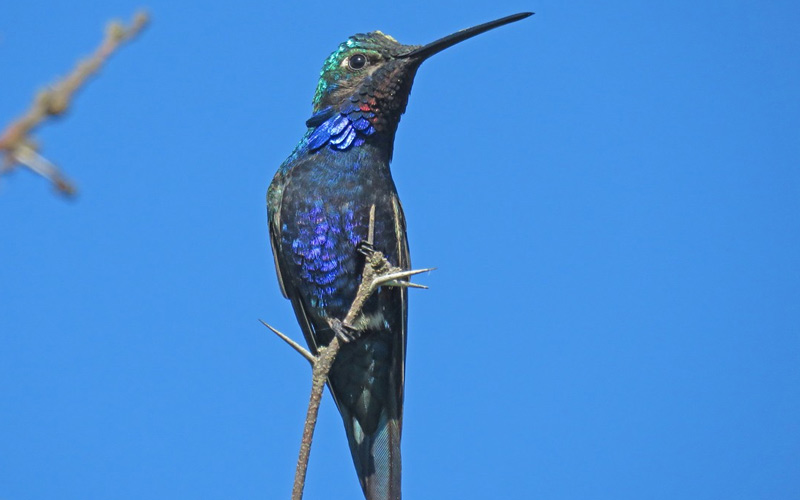
Source: ebird.org
The blue-tufted starthroat is an amazing species of hummingbird belonging to the “mountain gems” tribe of Lampornithini, which is a subfamily of the Trochilinae family.
This species of hummingbird has a bright blue tuft of feathers on its throat, which gives it a unique and attractive appearance.
This species is typically found in several South American countries, including Argentina, Bolivia, Brazil, Colombia, Paraguay, Peru, Uruguay, and possibly Ecuador. The blue-tufted starthroat is a very small bird, with an average length of around 4 inches.
Its wingspan is usually only about 2 inches, and its weight is usually around 3 grams. Its beak is very thin and needle-like, which allows them to seek out nectar from deep within flowers.
They have a very fast flapping flight, which helps them to quickly move from flower to flower in search of nectar. The blue-tufted starthroat is a solitary bird, and it usually nests in the tall trees of the rainforest.
During mating season, the male displays its beautiful blue tuft of feathers to attract a female. The female typically lays three eggs in a nest constructed with twigs and moss.
The eggs hatch after two weeks, and the chicks are cared for by both parents until they are ready to fly. The blue-tufted starthroat is an important species of hummingbird for many reasons.
It plays an important role in the pollination of flowers, which helps to ensure the health of the rainforest itself. In addition, its unique physical appearance makes it a favorite among bird watchers and photographers.
It is also valuable to the local economy, as its feathers are often used to make traditional items such as headdresses and jewelry.
| Kingdom | Animalia |
| Phylum | Chordata |
| Class | Aves |
| Clade | Strisores |
| Order | Apodiformes |
| Family | Trochilidae |
| Genus | Heliomaster |
| Species | H. furcifer |
33. Cream-backed Woodpecker
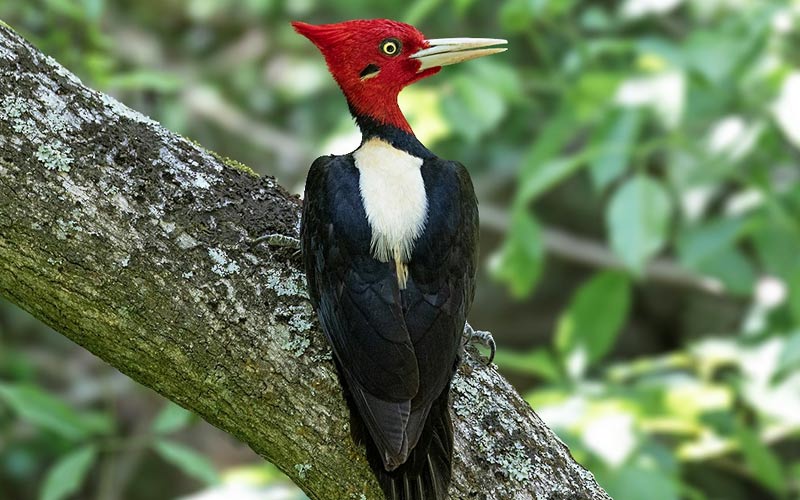
Source: ebird.org
The Cream-backed Woodpecker is a species of bird belonging to the family Picidae and the subfamily Picinae. This species of woodpecker is found in a wide variety of places throughout South America including Argentina, Bolivia, Brazil, Paraguay, and Uruguay.
This species of woodpecker is typically around 18–20 cm in length, and with its distinct coloring of a white head, white throat, yellowish-brown upper parts, a black tail, and a creamy-white back, these birds are quite easy to identify. The Cream-backed Woodpecker is often seen foraging for food in the forest, such as ants, beetles, and other insects.
This species is also known to feed on fruit, berries, and other vegetation. They are quite vocal birds, emitting a series of loud, raspy calls. These birds are cavity nesters, meaning they will often build their nests in holes in trees, often in dead wood.
The Cream-backed Woodpecker can be seen in a variety of habitats, including forests, savannas, and shrublands.
They are often spotted in pairs or small groups. Overall, the Cream-backed Woodpecker is a species of bird that is easy to identify due to its distinctive coloring and loud calls.
They are found in a wide variety of habitats throughout South America, and they are often seen foraging for food in the forest. They are cavity nesters, typically building their nests in holes in trees, and they are often seen in pairs or small groups.
| Kingdom | Animalia |
| Phylum | Chordata |
| Class | Aves |
| Order | Piciformes |
| Family | Picidae |
| Genus | Campephilus |
| Species | C. leucopogon |
34. Buff-winged Cinclodes
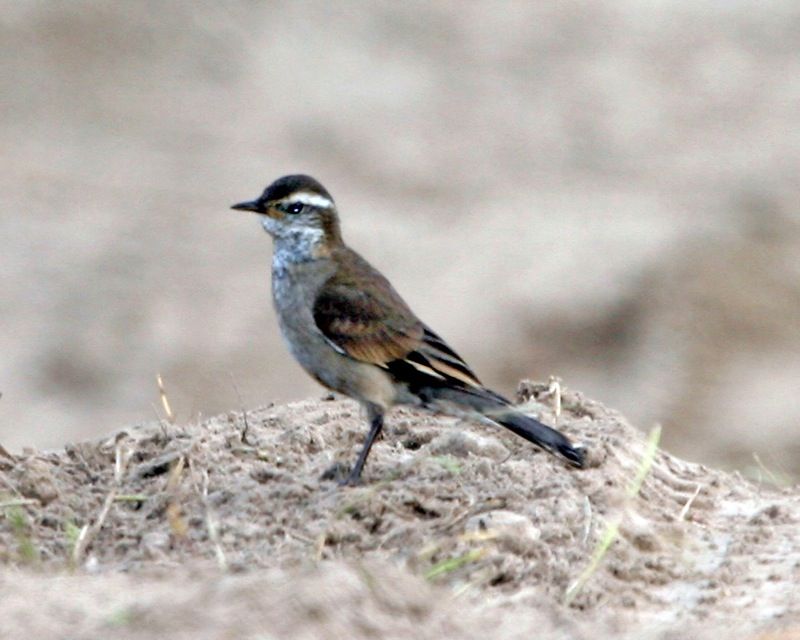
The buff-winged cinclodes is a species of bird that belongs to the Furnariidae family. It is native to Argentina and eastern Chile, but it migrates to the Pampas during the winter season.
This species was previously thought to be the nominate subspecies of the bar-winged cinclodes. This means that it was assumed to be the original or prototypical form of the species, but this is no longer considered to be the case.
They are now viewed as two distinct species with separate evolutionary paths. The buff-winged cinclodes is a medium-sized bird with a white belly and a light brown back. It has a long bill and a buff-colored patch on its wings.
It is mainly found in temperate grasslands, but it can also be seen in open woodlands and scrublands. It feeds mainly on insects, but it may also feed on small vertebrates and seeds. It is a non-migratory species and usually nests in burrows or cavities.
Its main threats are habitat loss and degradation due to agricultural and urban development.
| Kingdom | Animalia |
| Phylum | Chordata |
| Class | Aves |
| Order | Passeriformes |
| Family | Furnariidae |
| Genus | Cinclodes |
| Species | C. fuscus |
35. Yellow-billed Cardinal
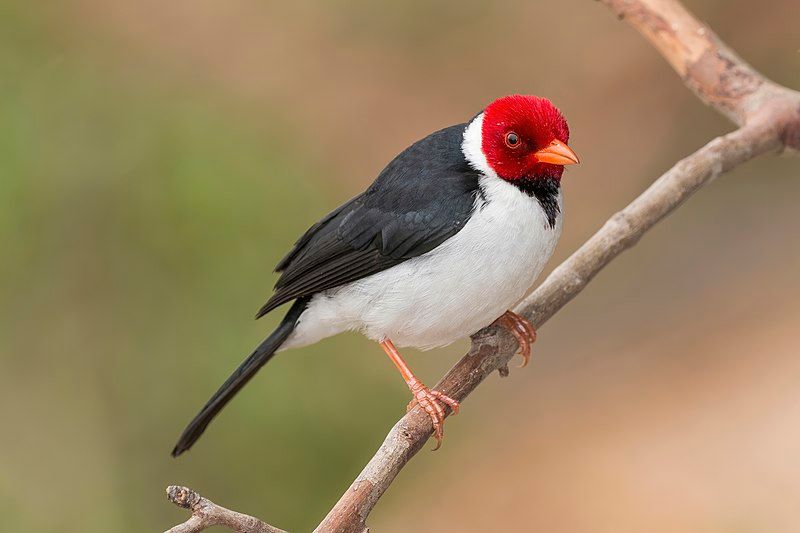
The yellow-billed cardinal is a species of bird from the Tanager family. It is not related to the cardinals that are commonly referred to as cardinals. This species of bird is found in South America, primarily in Brazil, Paraguay, Bolivia, Uruguay, and northern Argentina.
Furthermore, the yellow-billed cardinal has been introduced to the Hawaiian islands, where it has established a breeding population. The bird prefers moist shrubland habitats for its nesting and breeding grounds.
The yellow-billed cardinal is a unique species of bird that is found across South America and the Hawaiian islands.
| Kingdom | Animalia |
| Phylum | Chordata |
| Class | Aves |
| Order | Passeriformes |
| Family | Thraupidae |
| Genus | Paroaria |
| Species | P. capitata |
36. Red Pileated Finch
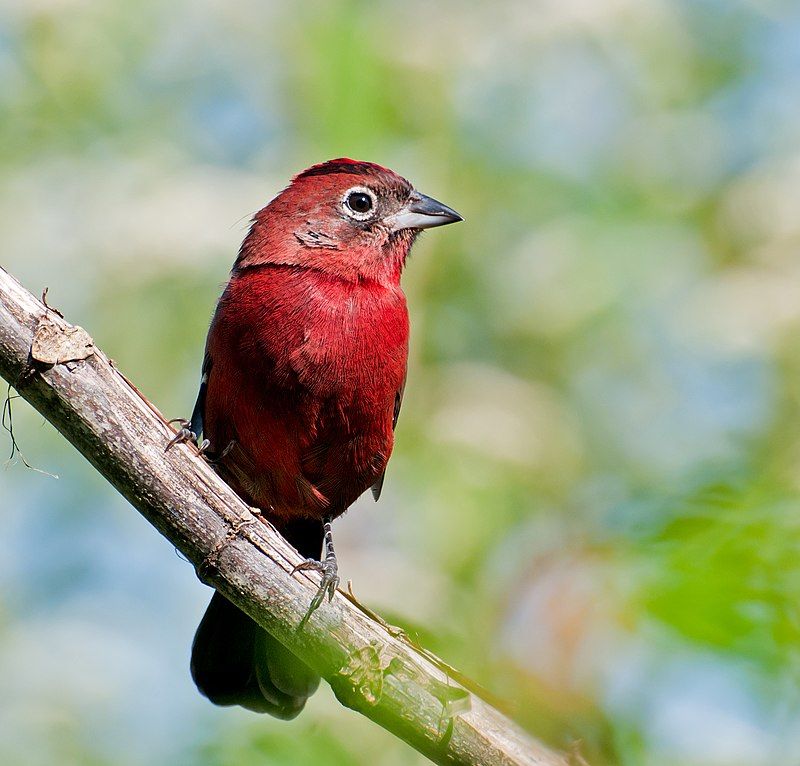
The red pileated finch is a species of bird belonging to the Thraupidae family. It is widely distributed throughout South America, from Argentina to Guyana. The red-crested finch is found mainly on the eastern side of the Andes mountain range, from Bolivia to French Guiana.
It is commonly spotted in countries such as Brazil, Ecuador, Paraguay, and Peru. The red pileated finch is a small bird with distinctive features. It is characterized by its red crest, which is a bright red patch of feathers on the top of its head.
Its body is brown with white underparts. Its wings are black, with some white patches, and its tail is yellowish-brown. Its beak is short and thick, and its legs are short and strong. The red pileated finch’s diet mostly consists of insects, seeds, and fruits.
It is an active forager, often seen hopping among branches and foliage in search of food. It is also known to feed on nectar and pollen.
They are social birds, often seen in small groups or in pairs. The red pileated finch is an important part of the South American ecosystem, as it helps to spread the seeds of certain plants and aids in the pollination of some flowers.
Its presence is a sign of healthy, diverse habitats. Unfortunately, its population is in decline due to deforestation and other environmental factors.
| Kingdom | Animalia |
| Phylum | Chordata |
| Class | Aves |
| Order | Passeriformes |
| Family | Thraupidae |
| Genus | Coryphospingus |
| Species | C. cucullatus |
37. Pantanal Snipe
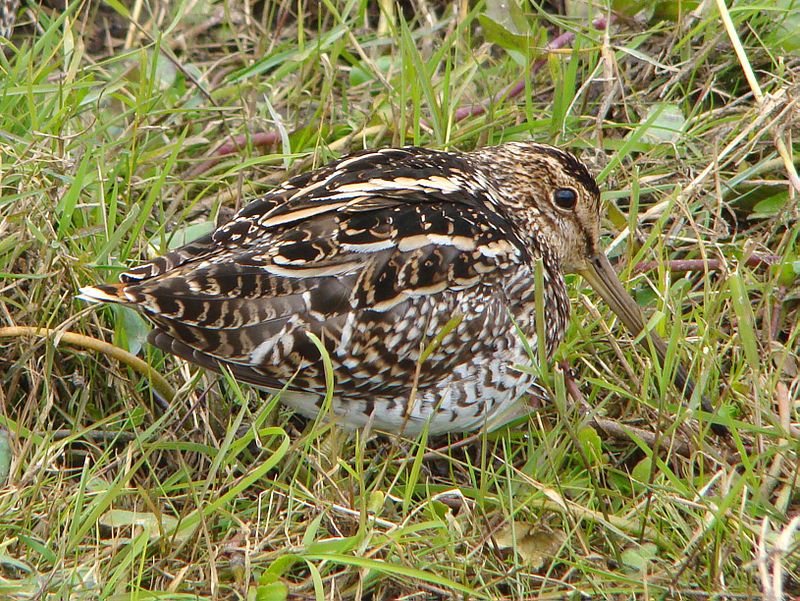
The Pantanal snipe is a species of bird belonging to the family Scolopacidae, which comprises sandpipers and their relatives.
This bird is found in many parts of South America, including Trinidad and Tobago, the Falkland Islands, and in every mainland country of South America except for Chile.
This bird is also a member of the tribe Scolopacinae and subfamily Scolopacinae, which are both part of the family Scolopacidae. The Pantanal snipe has a distinct plumage, predominantly grey, brown, and black in color. Its wings are short and its tail is pointed.
It is a small bird, only measuring around 18-20 cm in length. The Pantanal snipe feeds on a variety of insects, worms, and small crustaceans. In terms of habitat, the Pantanal snipe prefers open wetlands, such as marshes, swamps, and floodplains.
It is also fond of agricultural fields, particularly those with short vegetation. It is a migratory species and can be found in areas with suitable habitats during the non-breeding season, such as South American countries and the Falkland Islands.
The Pantanal snipe is not considered to be threatened with extinction, though its population is declining due to loss of habitat and changes in land use. Conservation efforts have been put in place to protect this species and its habitat.
| Kingdom | Animalia |
| Phylum | Chordata |
| Class | Aves |
| Order | Charadriiformes |
| Family | Scolopacidae |
| Genus | Gallinago |
| Species | G. paraguaiae |
38. Austral Negrito
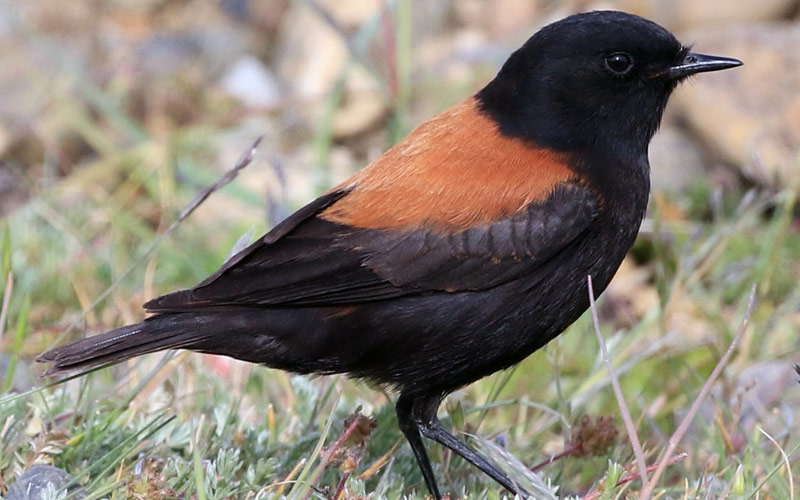
The Austral Negrito or Patagonian Negrito is a species of bird in the family Tyrannidae, which is a family of passerine birds.
This species is native to Argentina and Chile, but it has been known to migrate further north, even reaching as far as Bolivia, southern Brazil, Paraguay, and Uruguay.
In addition, it has been recorded as a vagrant in the Falkland Islands and the South Georgia and South Sandwich Islands territory. The Austral Negrito is a small bird, typically measuring between 14 and 16 cm in length.
Its plumage is mainly black with a white belly and throat, and it has a white eye ring and a white patch on its wings. It feeds mainly on insects, as well as some fruit and seeds. The Austral Negrito breeds in Argentina and Chile, typically between October and January.
The female lays 2-4 eggs in a nest made of twigs and leaves.
Both parents take turns incubating the eggs and feeding the chicks until they are ready to leave the nest. The Austral Negrito is listed as a species of Least Concern by the IUCN Red List, meaning that it is not considered to be threatened with extinction.
However, its populations are thought to be in decline due to habitat destruction and hunting. As a result, conservation measures are in place in some areas to ensure the species’ long-term survival.
| Kingdom | Animalia |
| Phylum | Chordata |
| Class | Aves |
| Order | Passeriformes |
| Family | Tyrannidae |
| Genus | Lessonia |
| Species | L. rufa |
39. Black-and-rufous Warbling Finch
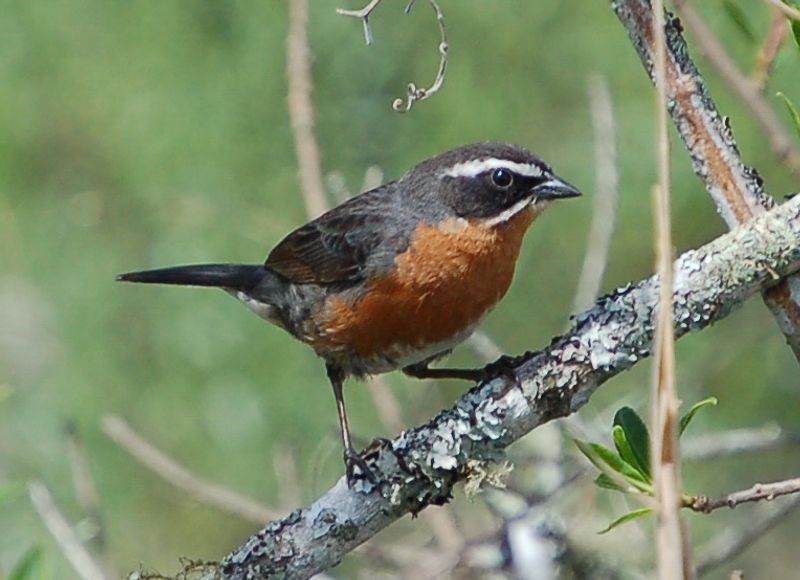
The black-and-rufous warbling finch is a species of bird native to parts of South America. It belongs to the tanager family Thraupidae and is found in Argentina, Bolivia, Brazil, Paraguay, and Uruguay.
This species prefers to live in a variety of habitats, including subtropical dry shrubland, subtropical moist shrubland, swamps, and degraded former forests. These areas provide the warbling finch with access to food sources, shelter, and space to nest and breed.
The warbling finch is a medium-sized bird with black and rufous plumage. It has a short, pointed beak, a white stripe across its forehead, and a white patch on its wings.
Although its diet is mainly composed of small insects and seeds, the warbling finch may also consume fruit and nectar. This species is a socially active bird that often forms flocks to search for food.
It is also known for its melodic song, which is used to attract mates and establish territory boundaries.
| Kingdom | Animalia |
| Phylum | Chordata |
| Class | Aves |
| Order | Passeriformes |
| Family | Thraupidae |
| Genus | Poospiza |
| Species | P. nigrorufa |
40. Rusty-collared Seedeater
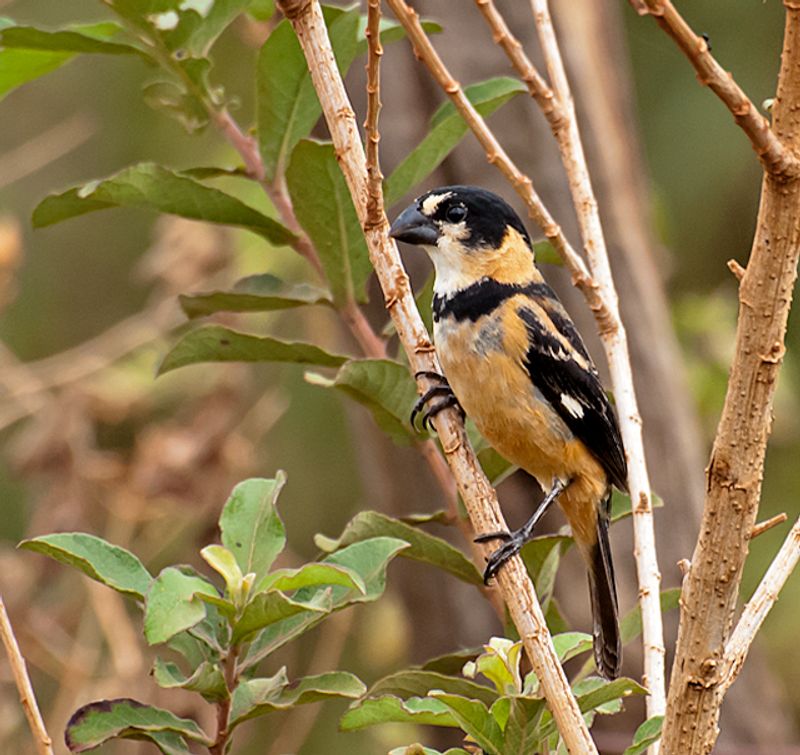
The rusty-collared seedeater is a species of bird found in South America. It is from the family Thraupidae, which is a family of passerine birds that includes various species of finches, tanagers, and sparrows.
Previously, the birds of this family were grouped together in the family Emberizidae. The rusty-collared seedeater is found in five countries in South America: Argentina, Bolivia, Brazil, Paraguay, and Uruguay.
It is usually seen in open and semi-open habitats, such as savannas, fields, and pastures. It feeds on various seeds from grasses, weeds, and shrubs. The rusty-collared seedeater is a slender-bodied bird, with a long, pointed bill and a rusty-brown collar on the back of its neck.
The upperparts are olive-brown, and the underparts are yellowish-pink. The wings are brown with white patches, and the tail is black. The rusty-collared seedeater is an active bird, often seen flying in small flocks.
The birds will often join mixed-species flocks, which help them find food and avoid predators. They are also known to join other birds in mobbing potential predators.
| Kingdom | Animalia |
| Phylum | Chordata |
| Class | Aves |
| Order | Passeriformes |
| Family | Thraupidae |
| Genus | Sporophila |
| Species | S. collaris |
Conclusion
The birds of Entre Ríos Province are a diverse and captivating variety of species that can be found in the region.
With its diverse ecosystems, the province is home to many rare and unique species of birds, including the Marsh Warbler, Grey-hooded Parakeet, and Pampas Meadowlark.
The rich birdlife of Entre Ríos Province provides a unique opportunity for birdwatchers and nature enthusiasts to observe and appreciate these wonderful creatures.